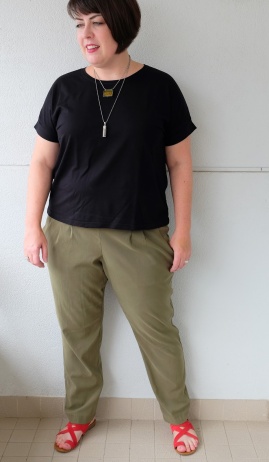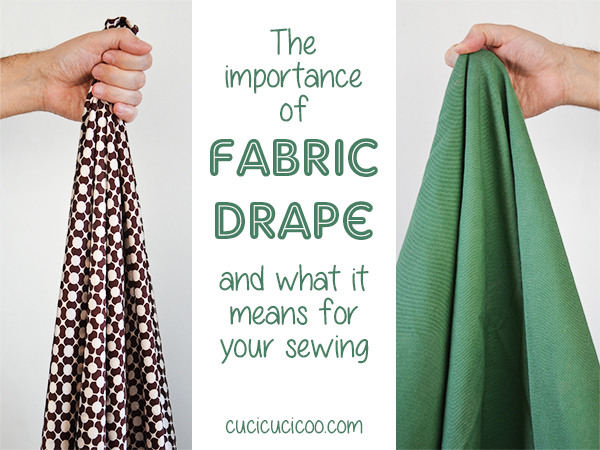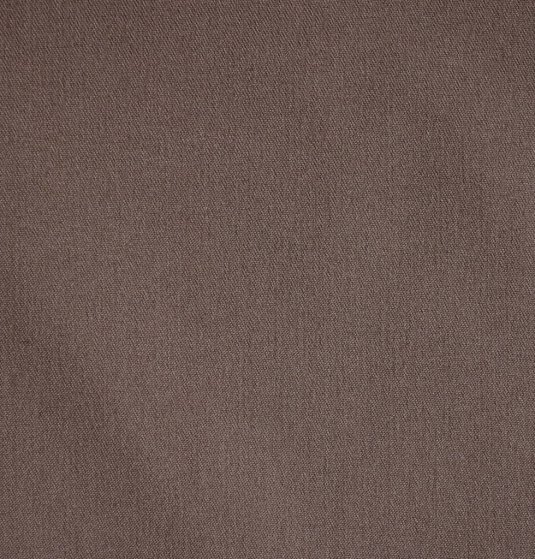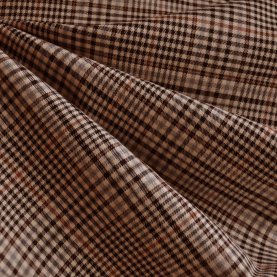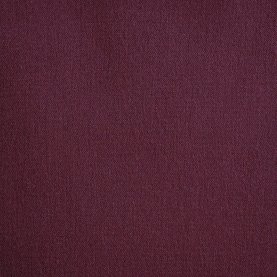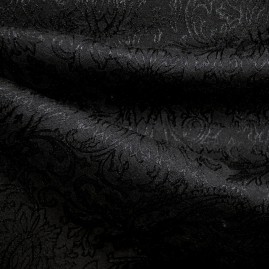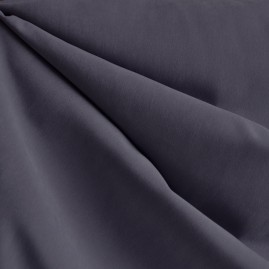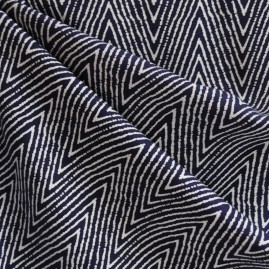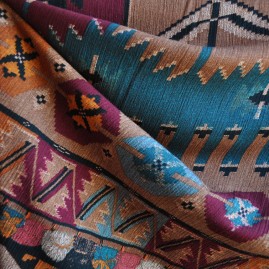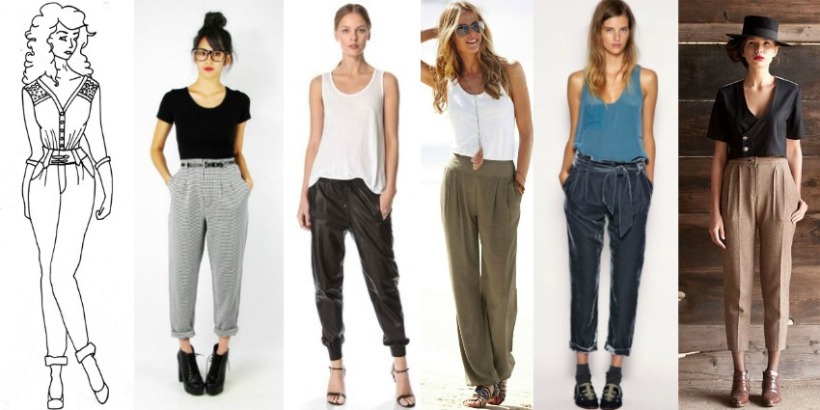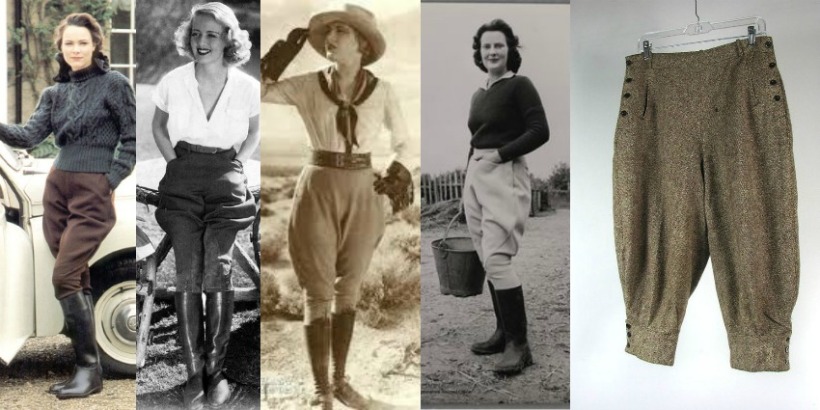

Sew-along with us!
Perhaps you'd like some company while you sew? We've sewn up each of our patterns and photographed each step along the way. Find the pattern you're after in the filter drop down below left.
Sew-Alongs
Lazo Trouser Hacks: The Parade
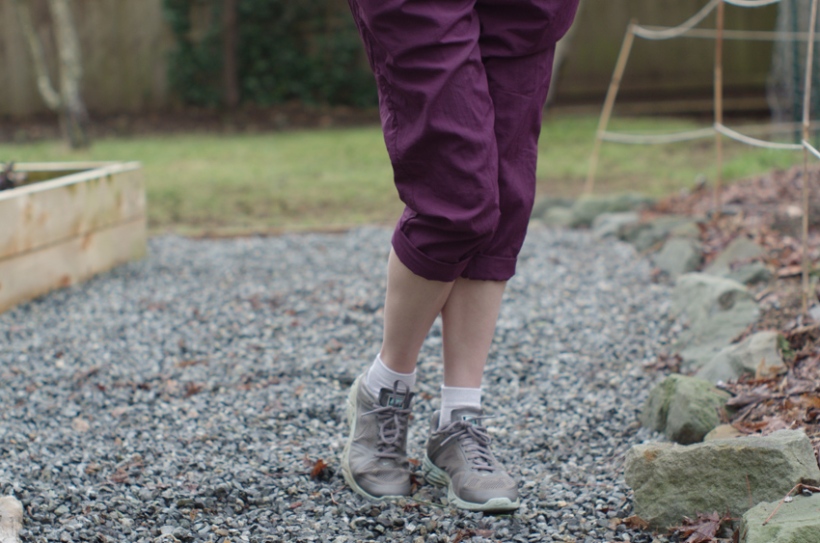
Okay guys, I have a surplus of Lazo Trousers to show you. This will likely be the last Lazo post for a while since it is the end of our Lazo Hack contest today! Don’t worry, the regular programming of menswear related sewing patterns and tools will be resuming shortly!

This week has been a great week for the Lazos – both in my wardrobe and throughout the online sewing community! Matt and I finally got around to a modelled photo shoot for the activewear pair that I made approximately two years ago (can you tell how much I like modelling…thank goodness our pup Luki helped me out!).
This pair is made in a complete mystery material that I suspect is mostly nylon. It was from the ‘activewear’ section of my local fabric shop and I picked it with the intention of making hiking capris. I liked that it had a bit of body while still being very light weight. Plus it is quick dry and a rugged twill weave.
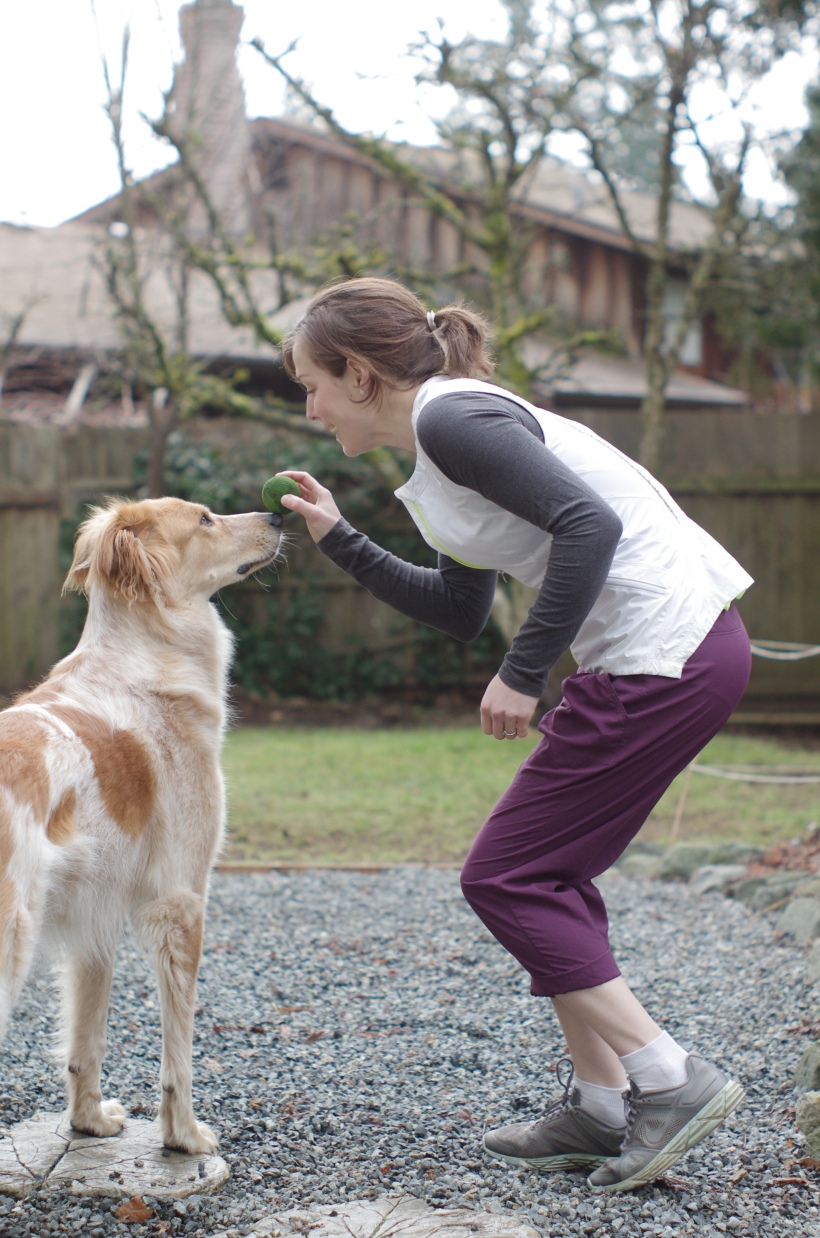
These Lazos are sewn in size 4 as is. I had fun adding lots of topstitching to this pair similar to how I would approach sewing our Jedediah Pants or a pair of jeans. I think this subtly changes the overall feel of the design from elegant to casual and rugged.

I added three heavy duty anorak snaps as a waistband closure and lined the pockets with a twill weave acetate lining (again, to be light and quick drying).
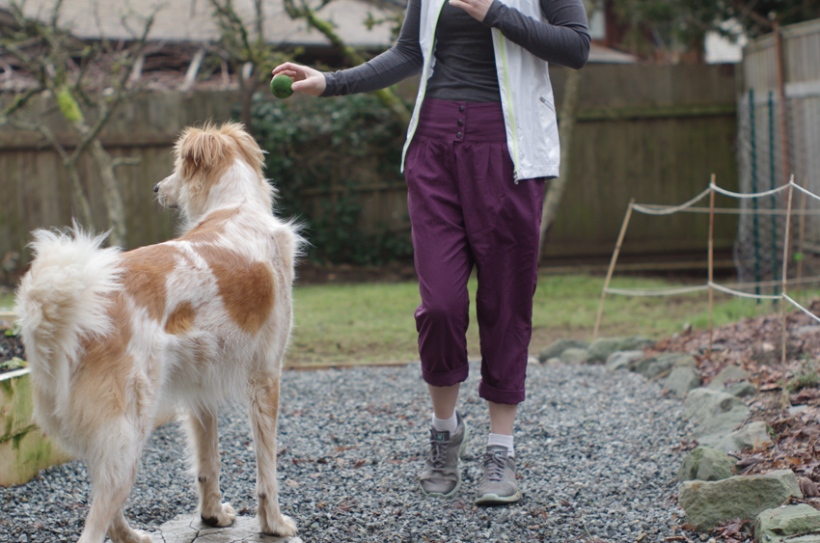
I look forward to some warmer weather so I can wear these hiking and boating again! They were NOT the right choice for a frigid afternoon near the end of January!
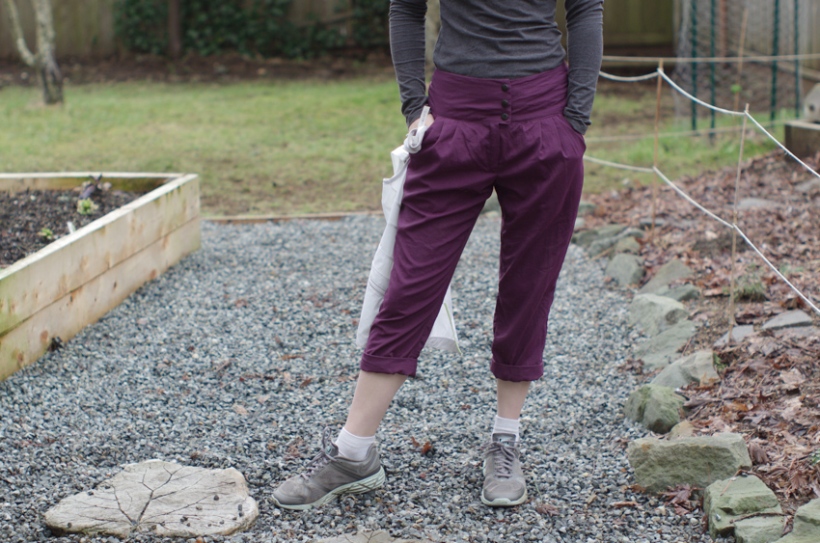
A few of you requested that I model the elastic waist Lazo Joggers from last week’s tutorial so Matt and I photographed those the same day. I added them to last week’s blog post, but in case you missed this update, here are a couple of photos of me in my pjs for you to see!

As you can most certainly tell from these images, this pair is much cosier and better suited to January weather. I really love them!
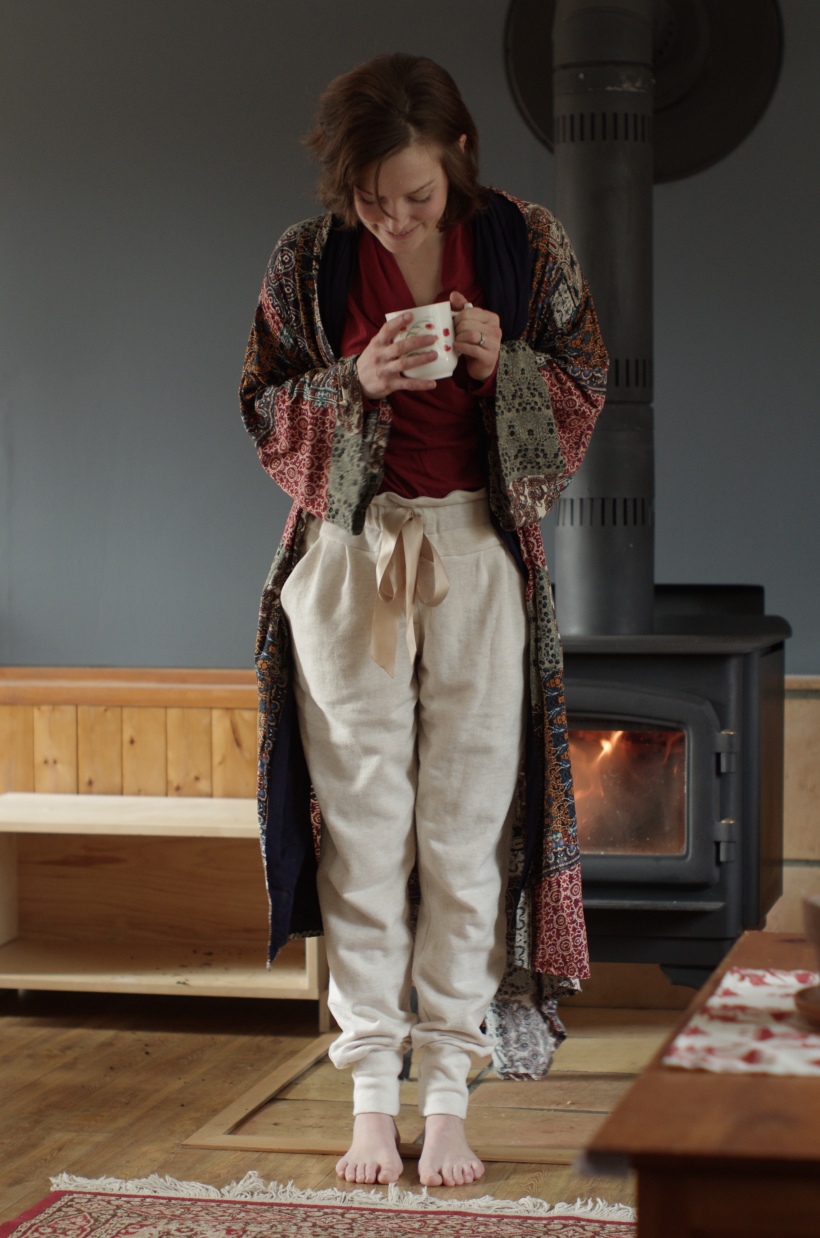
It wasn’t only me who modelled Lazos this week – I am so thrilled with the flat elastic waist Lazos that Meg created.
To my eye they retain the elegant simplicity of the original design while adding loads of comfort and convenience. Being an enthusiastic wearer of elastic waist pants myself, I think this hack is perfection. Plus, she went to the effort of making a tutorial to show us what she did! Thank you so much Meg! My next pair of Lazo Trousers will definitely include a flat elastic waist.
Lastly, I have a beautiful un-hacked pair of tencel Lazos to share with you that even feature the pointed belt loops of the original design:
The olive tencel, crisp white blouse and tropical greenery are a match made in heaven! I’m glad you love your Lazos and had a great holiday Kellene!
Let’s close off this Lazo overload by drawing the final winner of the Lazo Hack contest. Thank you to all who entered your creative brainstorming, your WIP shots and your finished trousers. The winner of the a Thread Theory sewing caddy filled with $100 of goodies is Orianne! Orianne entered by email with these beautiful sketches:
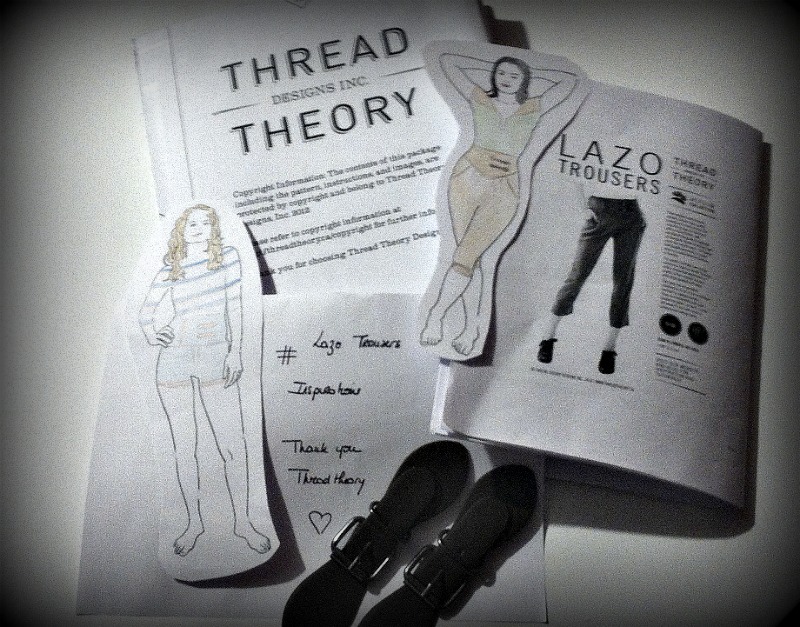
I will be emailing you, Orianne, so that you can select the items you would like me to pack in your box!
If you want to continue the conversation about Lazo hacks or perhaps pose a question to the Thread Theory sewing community, you will likely be interested to know that we now have a Thread Theory Sewing Community Facebook group! The intention of this group is to allow sewists who are considering, working on, or finished sewing with Thread Theory patterns to share their questions, their opinions and their projects. I hope it will be useful for you! It will not really be curated by me so it is up to you how you would like to use this platform.
Matt created it earlier this week but I must confess that I avoid Facebook as much as possible…so if you love Facebook groups and prefer ours to be structured in a more user friendly manner, just let me know and I will be happy to learn something about this!
Have a great weekend, everyone.
Lazo Trouser Hacks: Elastic Waistband Joggers
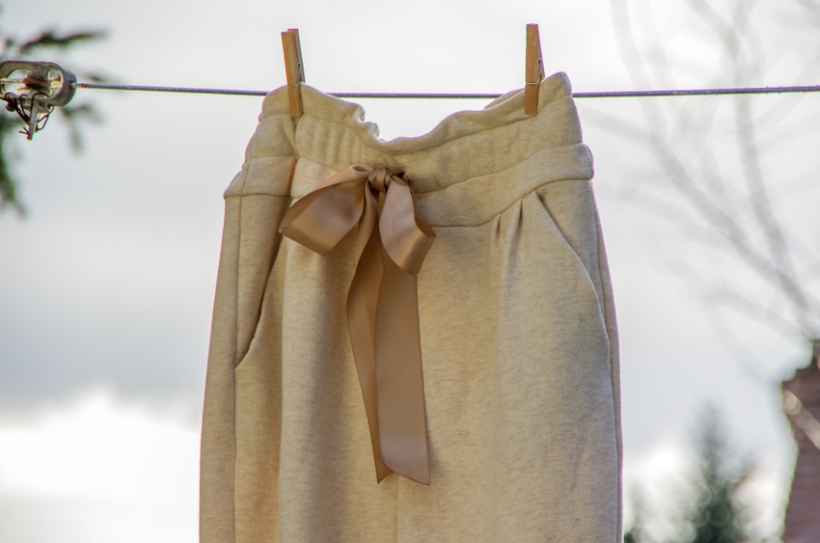
As promised, here is my contribution to the ongoing Lazo Hack contest. I’ve made a few simple adjustments to the Lazo Trousers pattern to produce elastic waist joggers with a satin ribbon drawstring!

While working on these joggers last night I snapped a few pictures to create a tutorial for you. I’ll show you how to adjust the front waistband so that it is one piece, switch the fly from functioning to a mock fly, and add elastic and buttonholes for a drawstring. You can hem the trousers as per normal or you can add some narrow cuffs at the ankle as I did.

(Velvet jogger inspiration from Anthropologie. I love the tassel drawstring!)
Transforming the Lazos into joggers is a VERY simple hack that could work for both woven and knit fabrics. Any woven fabric that you might choose for a regular pair of Lazos will work for these joggers (chambray tencel or velvet would be awesome!). If you want some jogger inspiration, here is a good series of styled images. I’m probably a bit late to the jogger trend (I think it began in 2014) but I’ve never really adhered to trends anyways, I just choose my clothing based on my current lifestyle and mood.
Ok, let’s convert the Lazos to joggers:
Begin by selecting and altering your pattern pieces. The only pattern piece you do not need to use is the Zipper Shield.
The only pattern piece you need to change is the Waistband Front – simply fold under the extension at the notches and cut the waistband on the fold (just like you cut the back waistband). There is no need to cut interfacing pieces for the waistband or fly.
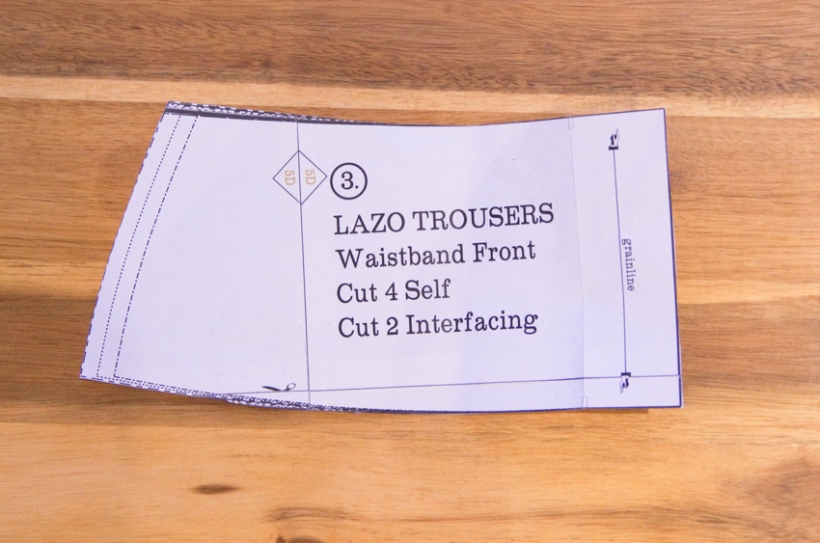
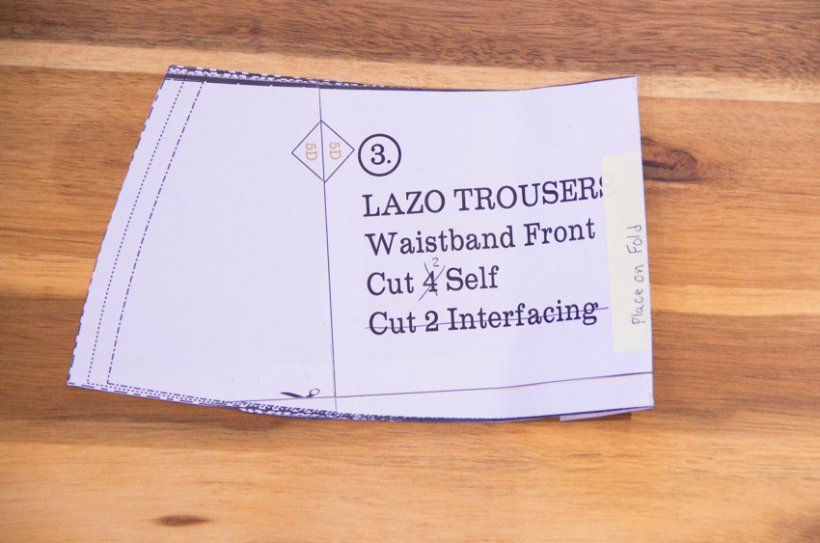
Assemble the trousers as per the instructions all the way up to the Fly Front section. If you are working with a knit, you might like to use a stretch stitch or a serger so that your seams are not at risk of snapping when the fabric stretches.
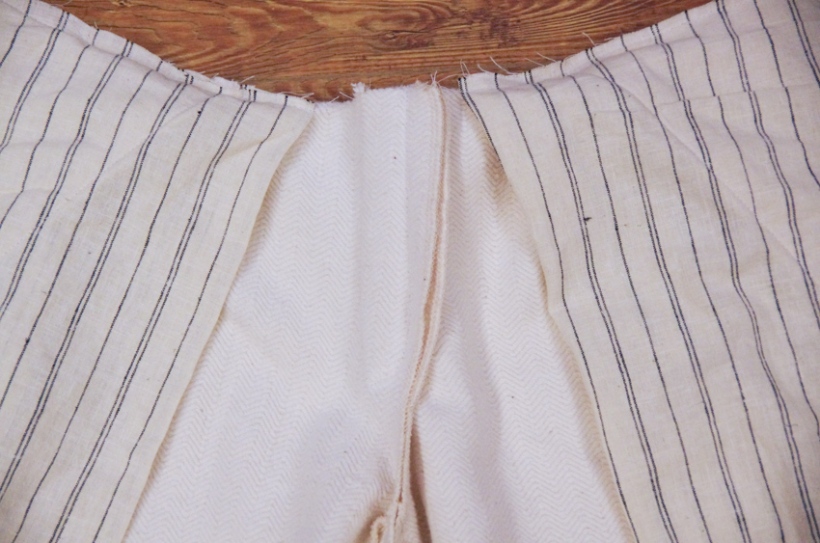
To create the mock fly finish the seat seam as instructed. Next, sew the inseam, but instead of stopping just below the zipper placement notch, ignore the curved fly facing and stitch in a straight line all the way up to the fly facing notch (which is the centre front of the pants). If you prefer to leave off the fly altogether (perhaps you would like to insert a side seam invisible zipper instead), you can trim off the fly facings. To sew the mock fly, press the facings towards the right side of the trousers (if you were wearing them).

On the right side of the trousers, topstitch as you would normally to give the illusion of a functioning fly.
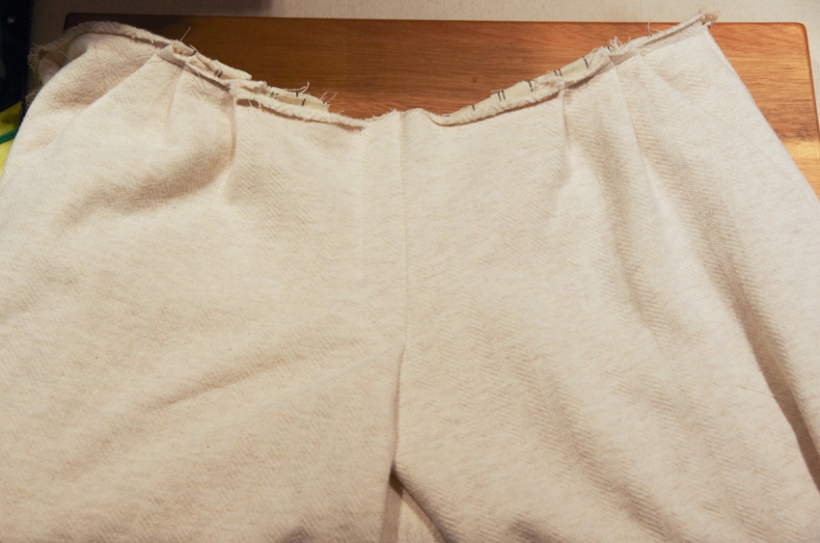
Now we are ready to assemble the waistband! If you would like to add a drawstring later, now is the time to add buttonholes to your waistband front. Apply a small square of interfacing to the centre of the waistband on the wrong side of the fabric. This will help to stabilise the fabric when you sew your buttonholes and it will make your buttonholes less likely to become misshapen with use.
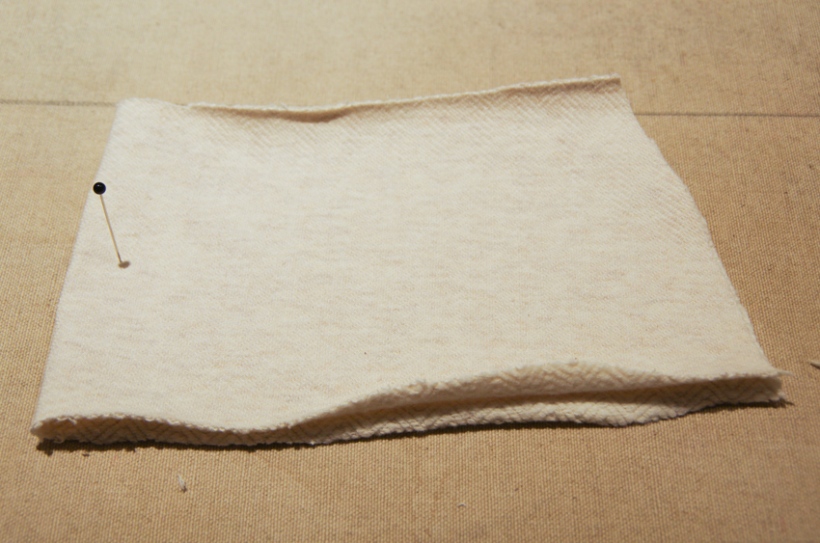
To position your buttonholes, fold the waistband front in half and measure in from the fold 1/2″. Place a pin through both layers of fabric and then mark the pin’s position with chalk (preferably on the wrong side of the fabric so that you don’t have to wash out your chalk as I did! Sorry for the wet waistband later on in the post…I was on a roll while I was sewing and didn’t want to stop to wait for the fabric to dry!).

I chose to add 1/2″ buttonholes but you can add whatever size you prefer based on the drawstring that you choose.
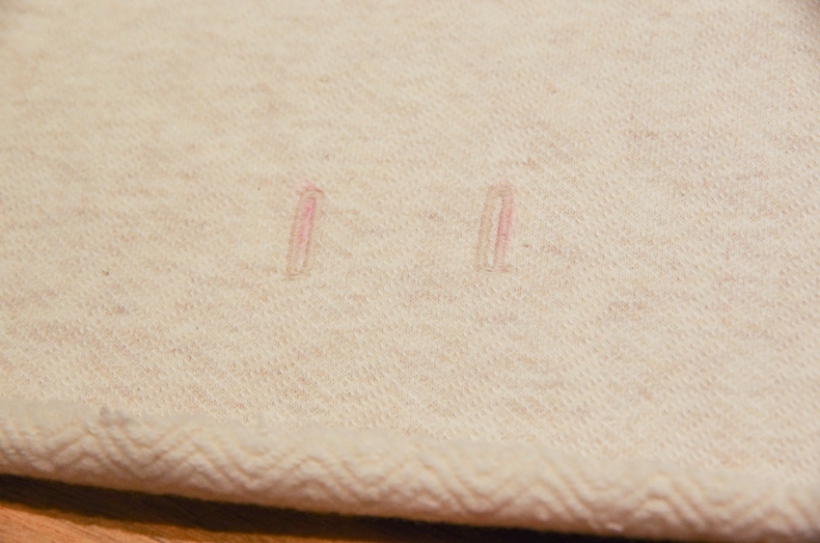
Now place the waistband front and back with right sides together and sew the side seams. Repeat this step for the waistband facings (the second set of waistband pieces).

You now have two waistband loops. Place these with right sides together and sew along the entire top edge. By the way, at this point it would be easy to make your waistband shorter by simply chopping off the top of the waistband before you sew the two loops together. You could choose to match the width of elastic you plan to use for instance. I left my waistband the full height because I wanted them to be high rise trousers. Centring the 2″ elastic within the waistband resulted in a bit of a paper-bag silhouette. If your waistband does not extend above the elastic your trousers will not have a ruffled top edge as mine do.

You might like to understitch along the top of the waistband to prevent the facing from rolling outwards.
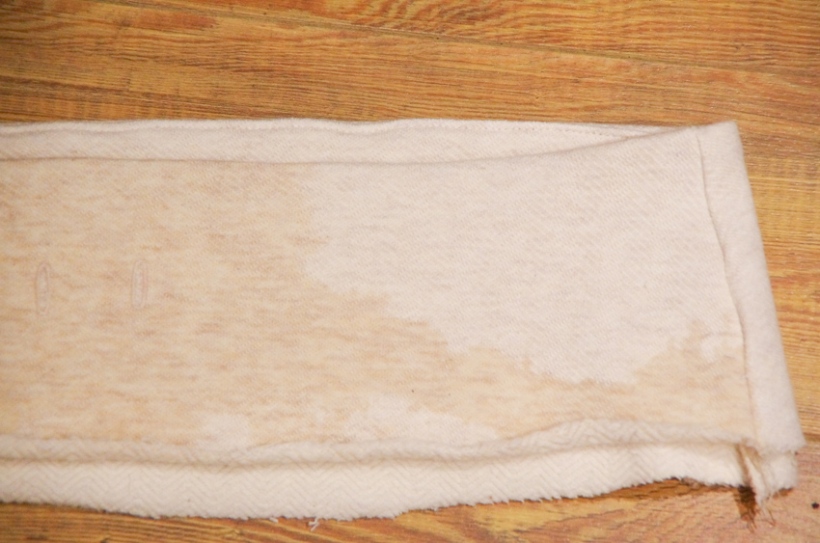
Attach the waistband to the trousers while keeping the waistband facing free. Place the waistband and trousers with right sides together. Make sure to centre your buttonholes over the seat seam and align your side seams.
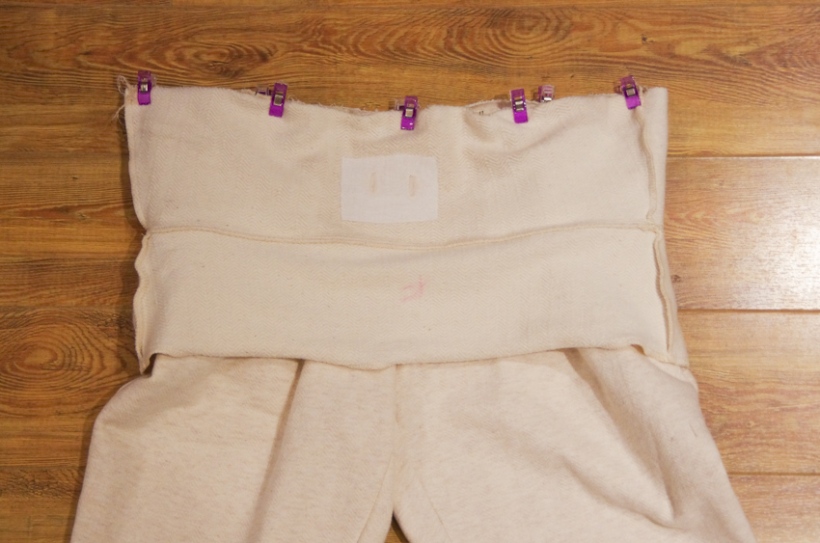
Press the seam allowances towards the waistband and then press the waistband facing downwards to enclose all of the raw edges. You can either finish the waistband facing edge at this point or you can press under the seam allowance for a very tidy look. I left my serged edge visible because my fabric is pretty bulky so I didn’t want to add another layer of fabric.
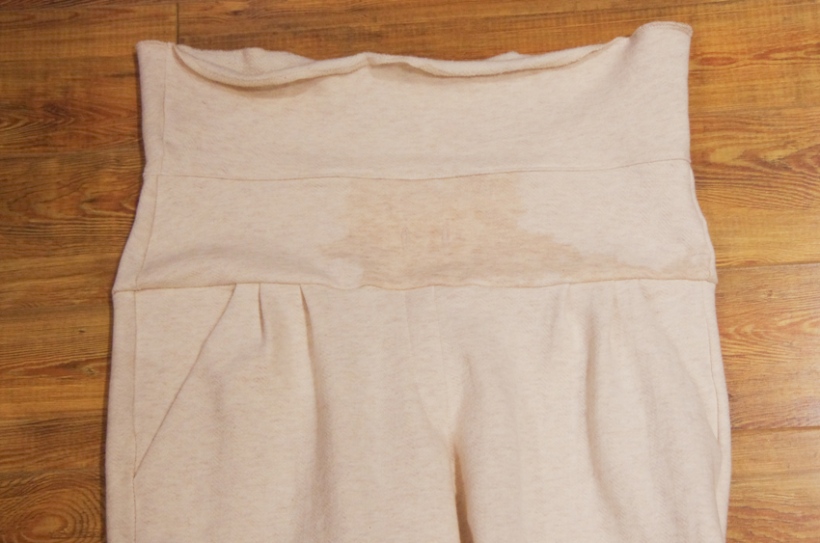
Pin the waistband facing in place carefully. I would highly recommend basting it in place so that you don’t have to worry about it shifting during the next step!
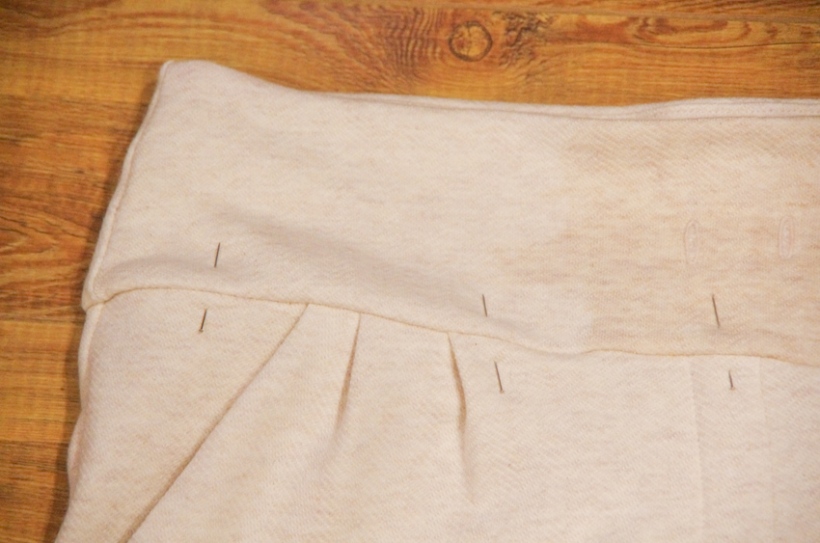
From the right side of the trousers, start 1″ away from one of the side seams and stitch in the ditch all the way around the waistband. Finish your stitching 1″ away from the same side seam so that you are left with a 2″ opening at the bottom of the waistband facing. You will use this opening to insert the elastic.
Circle elastic around your waist to find the perfect fit. I circled mine at my natural waist but if you have shortened your waistband to fit your elastic width, circle your elastic a couple of inches below your natural waist since the trousers will now sit lower. Remember to include some extra elastic so that you can overlap the ends later to create a loop!
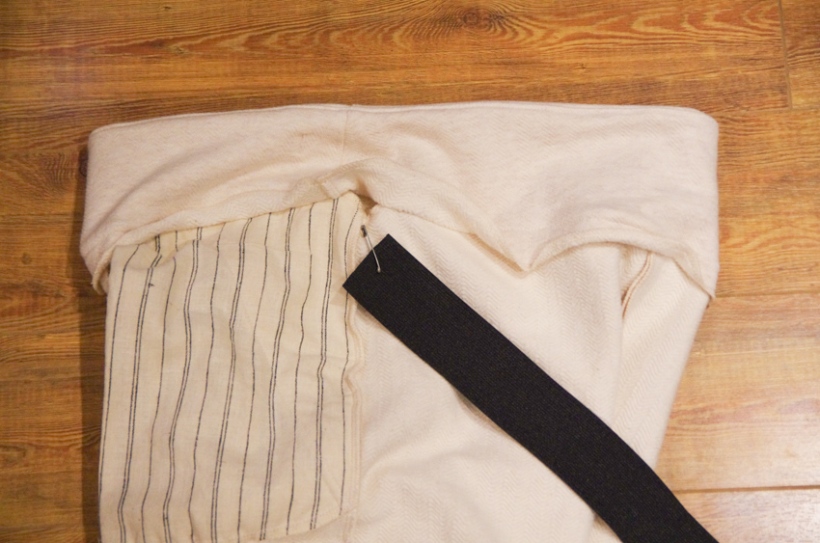
Thread the elastic into the opening using a safety pin. Once both ends are pulled out of the opening check that the elastic is not twisted within the waistband and then overlap the ends and stitch them together.

Close the elastic within the waistband by stitching in the ditch over the 2″ hole.
Try on your Lazos to check the length of the hem (and to admire how they look!). Hem them in the style that you choose (a regular hem, a wide cuff or a narrow ribbed cuff like mine).
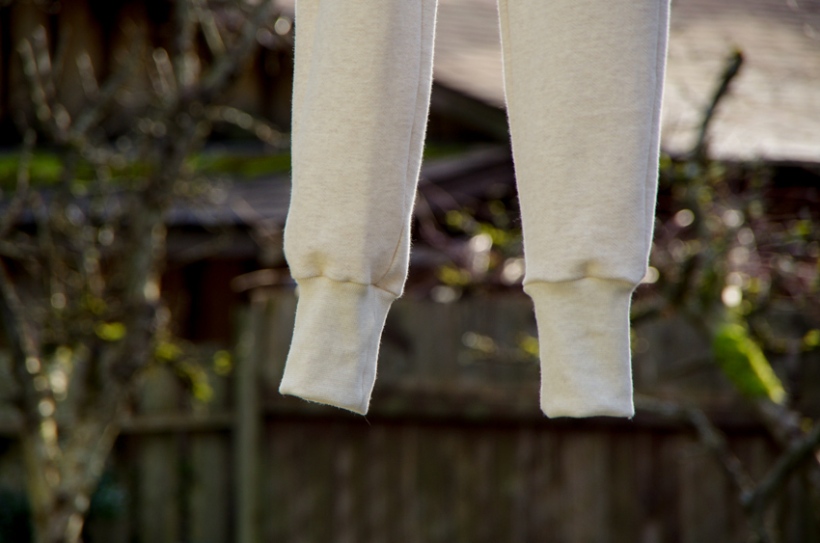
Now you have several options to prevent your elastic from shifting around in the waistband. The simplest option is to distribute the fabric nicely around the elastic (while you are wearing the trousers) and then place a pin through the side seams and elastic. Stitch in the ditch of the side seam to secure the elastic in place.
To create the paper bag waist and more thoroughly secure your elastic in place, you can toptstitch along both the top and bottom of the elastic around the entire waistband.
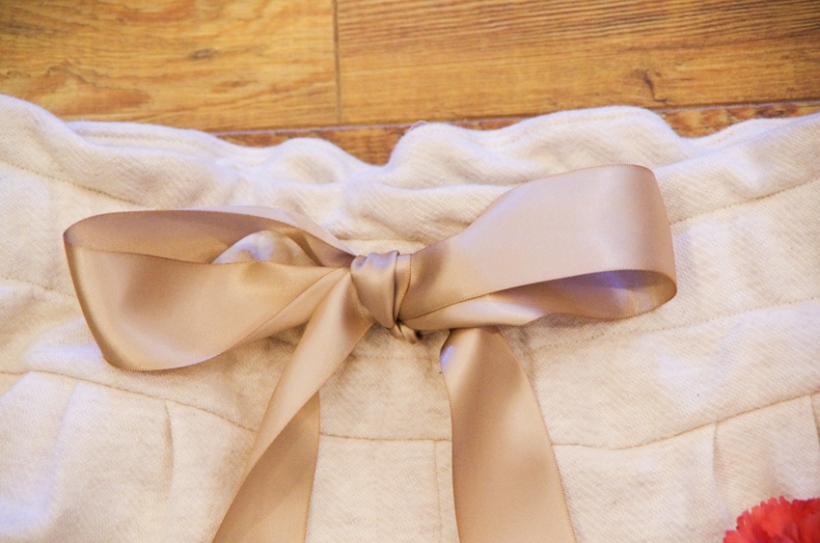
Now all you need to do is thread a drawstring through the buttonholes using the same safety pin technique is before and your joggers are complete!
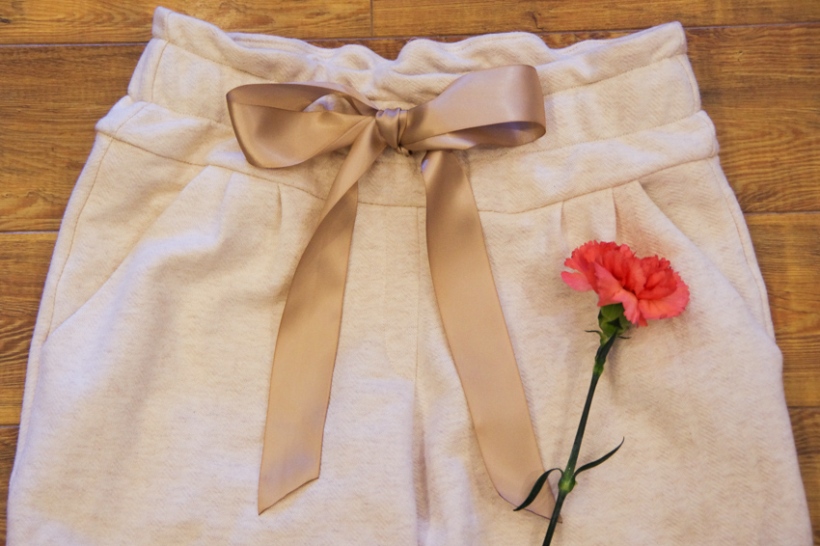
I hope you like my fresh interpretation of the Lazos Trousers! Have you tried hacking them yet or do you prefer to sew them as is?
Edit Jan 25th: Some of you asked me to model these Lazos for you – here I am in my jammies ;-) They look pretty cozy eh?

To finish off Friday in a happy sort of way, let’s do the third Lazo Hack contest draw! Today’s winner is Meg (@madebymegblog)! Check out the awesome way she styled her Lazos.
The rolled hems and boot combo is really wearable and cute! Congrats Meg, your use of #lazotrousers has won you $25 to Blackbird Fabrics. Thanks for sharing!
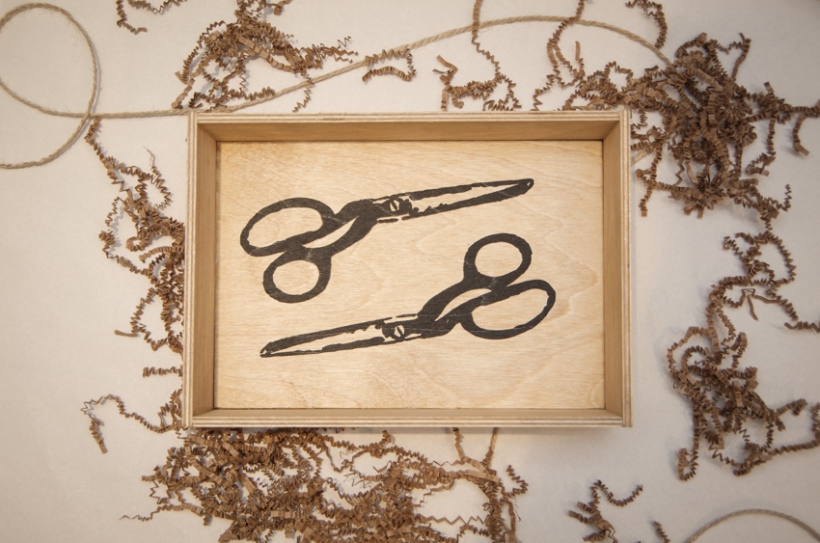
I will draw the last Lazo Hack prize on Friday, Jan. 27th. The winner will get to choose which goodies (from our shop) they would like me to fill this sewing caddy with – up to a $100 value!
You have 7 days to take a photo of your Lazos whether they are still a work in progress or finished and share them on Instagram or Facebook using #lazotrousers.
Lazo Trouser Hacks: Fitting
Happy New Year! I’m getting right in to the swing of things on the blog today now that the busy holiday season is over. It’s finally time for the Lazo Fitting post! Sorry for the delay on this one. I just couldn’t fit it in before my Christmas break.
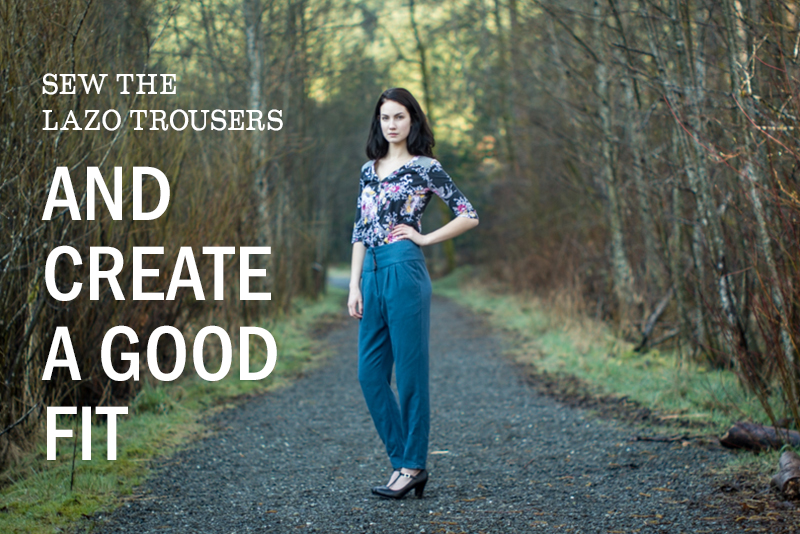
I have included fit adjustments based on the feedback you gave me several blog posts ago. If I missed a category or you didn’t have a chance to request a fit adjustment, shoot me a comment on this post so that I can try my best to provide you with some fitting help.
I have chosen the simplest solution for each fit problem so I hope this post won’t intimidate you! Also, you will notice that a lot of my solutions use the Lazo’s unique style lines to help fit. We will work with the waistband shape and also with the pleats to create a better fit when possible instead of performing more elaborate pattern manipulation.
Now, please, before we get started, please add a mock up (trial run) of the Lazo Trousers to your agenda! All of these fitting suggestions are operating under the assumption that you have sewn a mock up using the size that best matches your hip circumference and a fabric that is fairly similar to the actual fabric you plan to use for your Lazos. Once the mock up is sewn, you will be able to see how the Lazos fit you and you can pin them tighter where needed or cut them open where needed to get an idea of where you need to adjust the actual pattern pieces. If you want to see this process in action, check out the photos that I took of Matt in his Fairfield Button-up mock up…he looked like Frankenstein but it was a great visual way to see where adjustments were needed!
Wide Hips
When choosing your Lazo Trousers size, I would recommend picking the size that matches your hip measurement most closely. If your hips are proportionately wider than our fit model’s hip measurement, you will likely need to adjust the fit of your trousers at the waist.
Here is an example: Your hip circumference is 42 7/8″ so you choose to work with size 14. Your waist measurement is only 29 7/8″ (which, is a size 10 for our Lazo Trousers). Select the size 14 pattern and then adjust it to suit your other body measurements.
To bring the waist in to match your proportions, you can grade between sizes only on the waistband pieces. The fullest part of the hip curve is positioned at the bottom edge of the waistband so you will need the bottom edge to remain the larger size to match your hips. This makes it very easy to work with two sizes because you don’t need to worry about adjusting the pocket pieces!

Of course, your wide hips might sit higher or lower than the Lazo Trousers hip curve. I would recommend making a mock up after grading between sizes. Try on the mock up to see if there is any strain or bagging along the curve of the hips. Adjust the shape of the curve accordingly. Note that you will need to adjust the pocket facing and pocket to match your new curve. I find it is easiest to do this by lining up the pieces how they will be sewn together (as I have done with the pocket facing in the image below), that way you can copy the hip curve on to the smaller pieces:

It is remarkably common to have two different shaped hips – you will notice that your mock up pulls on just one side of the body. This is because we generally have a dominant leg that gets used more often – it develops more muscles and becomes bigger. During the pant fitting class that I took a couple of summers ago, my classmates and I were surprised to find that the majority of us needed to adjust for a hip that was higher or larger than the other hip. For most of us, it was our right hip. To make the pants look symmetrical on an asymmetrical body, you can adjust one hip but not the other. I don’t think I would do this unless the larger hip was very noticeably causing asymmetrical strain lines.
Crotch Depth is Too Long
As I mention within the instruction booklet, the Lazo Trousers feature a very closely fitted seat seam. This creates a flattering, fitted appearance to balance out the roomy double pleats. It is very likely that the crotch depth of our fit model will not match your crotch depth exactly. Don’t ignore this because you may end up with uncomfortably tight trousers that try to give you a wedgie!
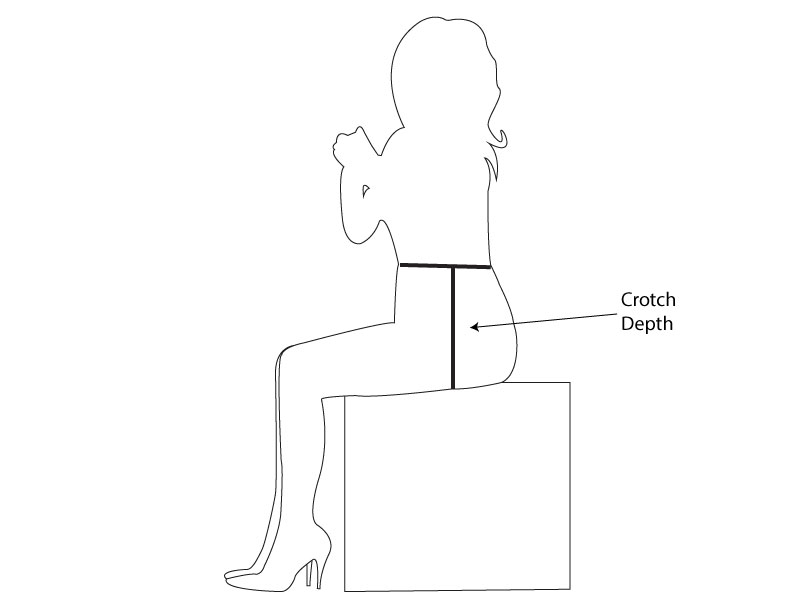
Measure your crotch depth as I illustrate in the booklet and then slash across your pattern pieces and spread them apart. Adding crotch depth will ‘drop’ the crotch – a little adjustment goes a long way! I recommend adjusting slightly less than you think you need in order to maintain the very fitted appearance of this seam.
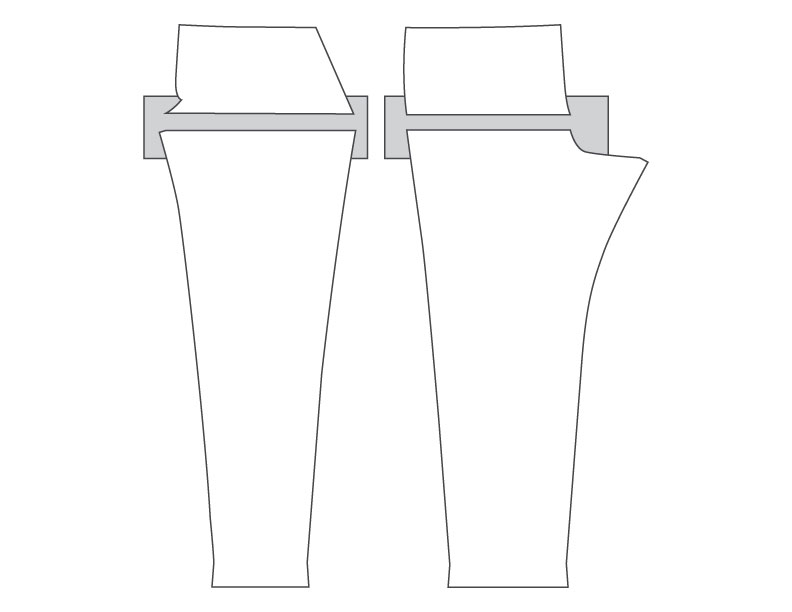
It is important to adjust the crotch depth before adjusting for a full tummy, flat tummy, full bottom or flat bottom. Changing the crotch depth will change all other pressure points because the pants will sit lower on the body (the crotch length is increased). Make up a mock up before proceeding to the other fitting issues – you may find that they no longer exist!
Full Tummy
This is a very important adjustment for the Lazo Trousers because the contoured waistband fits snugly and the bottom of the waistband will likely sit against the fullest part of the tummy – you do not want this to be cutting in to you! You want it to match the width and curve of your body.
If you are unsure whether you require a full tummy adjustment, circle a measuring tape around your waist (the narrowest point). If you have a full tummy you will find that the measuring tape naturally wants to ride up at centre front and sit lower at centre back. This is okay, of course! Let the measuring tape do this when you measure your waist…just know that you will need to add more length to the front of your trousers so they have room to curve over your tummy.
Here is my preferred way to add a combination of length and width to accommodate a rounded stomach. You will need to adjust the Waistband Front and the trousers Front.

Cut your pattern piece vertically down to the knee. Turn your scissors 90 degrees and cut across the knee leaving a hinge at the side seam and the inseam. Cut horizontally at the hip as well (at the bottom of the slash pocket). Spread open to add as much width at the waist as needed. Add the same amount of width to the waistband.
If you wish to avoid any fancy pattern manipulation, a very simple way to add some width to the Lazo Trousers front could be simply letting out one (or both) of the pleats! You would need to add width to the waistband accordingly. If you only sew one pleat on each pant leg, you would add 3/4″ to the waistband (for an extra 1 1/2″ overall). If you do not sew any of the pleats you would need to add 1 1/2″ to the waistband (for an extra 3″ overall…a very large adjustment!).
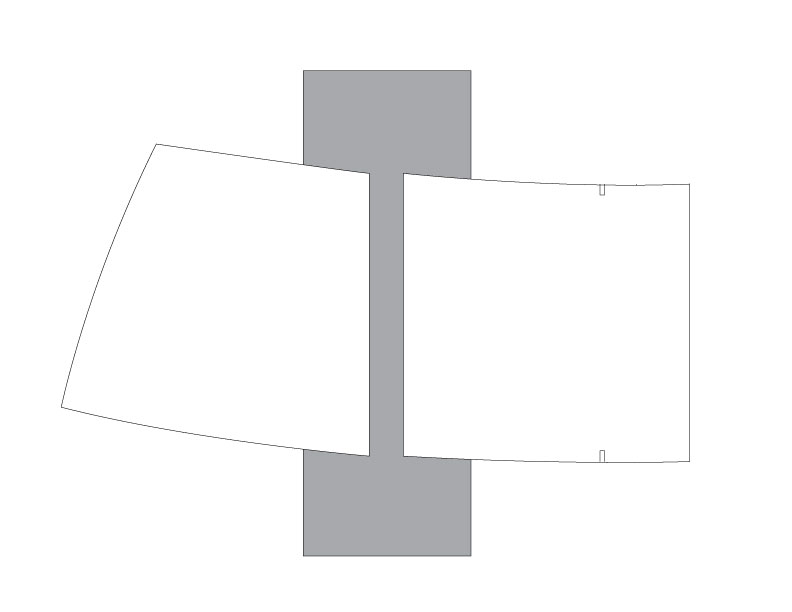
If you do not need the extra width at the top of the waistband because you have a narrow waist, you could add width in a wedge shape instead of spreading them apart evenly. The wedge would tapers to less or nothing at the top of the waistband.
Flat Bottom
There are no darts on the Lazo Trousers since the shaping needed for the curve of your bottom is built in to the waistband seam. If you have a flat bottom you will likely notice two fit issues when you sew a mock up:
- The waistband appears to be wrinkled and sagging because it provides too much room for your bottom.
- There are folds of fabric below your bottom at the back of your legs – this is because the back of the pants are too long since they do not have to curve over a round bottom.
These two issues mean that the trousers do not need as much width or length to curve across your bottom horizontally or vertically.
Try adjusting the curve of the waistband. I show you how to adjust the curve in the instruction booklet to suit a full bottom in the last illustration within the “Fitting the Waistband” section. The adjustment needed for a flat bottom is the opposite.
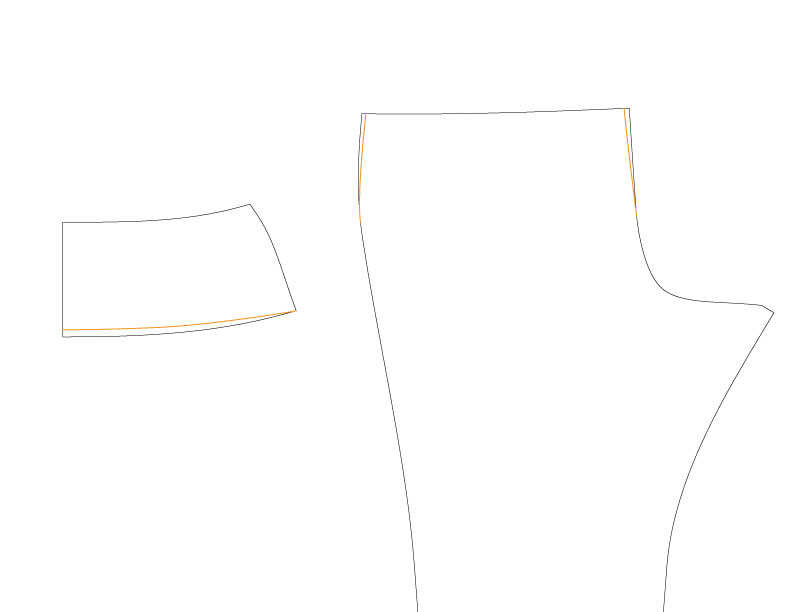
This is equivalent to making shallower darts. You will likely need to decrease the width of the trousers slightly since your straightened waistband seam is shorter than the original curve.
Now that the Lazo seat has been made flatter to suit your bottom, you will probably still need to reduce the length of the seat seam only on the back pattern piece. This will get rid of the fabric that pools just below your bottom. This adjustment is quite easy! Just cut in to the Back pattern piece somewhere near the middle of the seat seat seam and leave a little paper ‘hinge’ near the side seam. Using the hinge, overlap the paper so that you remove the excess length. You will likely only need to overlap 1/2″ or so.

Full Tummy paired with Flat Bottom
Okay, this might seam a bit repetitive, but this combination of fit adjustments is very common so it is worth giving a category of its own so that you can recognise the problem and then head for the correct solution.
You will notice, if you sew a mock up of the Lazo Trousers, that there is excess fabric pooling around your bottom while there are diagonal wrinkle lines over your crotch…it may feel a bit intimidating to be faced with trousers that are too tight and too loose simultaneously! To top it off, your side seams will not fall straight since they are being pulled towards the front. Don’t worry, all of these issues stem from the fact that the crotch curve does not fit your body. – you need to add length to the front to accommodate your lower tummy and you need to remove length from the back since the trousers do not need to curve much over your bottom. Perform the previous two adjustments!
Full Bottom
The Lazo Trousers are drafted to fit a figure with a fairly full bottom in relation to the waist measurement (an hourglass figure). All the same, if you make a mock up and notice that there is strain across the widest point of your bottom (or, maybe you notice that fabric is pooling directly above the widest point of your bottom), you might like to give yourself a little more room. If the strain is near the waistband seam, you can create more room by exaggerating the curve of the waistband (as I illustrate in the instruction booklet). Exaggerating this curve will simultaneously add a little more width (the seam becomes longer) and more shaping. You will likely need to add more width to the pants back as well so that they can be easily sewn to this longer waistband seam.

If the widest part of your seat falls below the waistband seam or if a fairly large adjustment is needed, you will likely want to add more length to the seat seam by adding a wedge at centre back in addition to addition to the extra width. Just as I described for the Flat Bottom adjustment, slash across the back pattern piece and leave a “hinge” at the side seam. This time, spread the slash apart and redraw the seat seam curve smoothly.
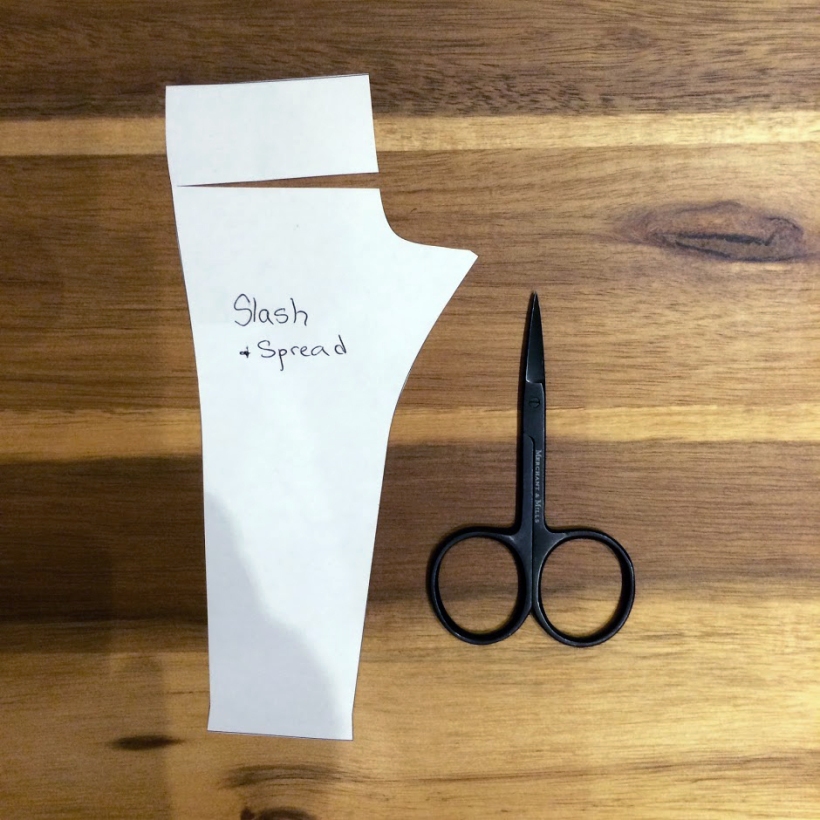
Straight Figure
Someone with a straight figure will likely find that, when they choose their size based on their hip measurement, the waistband is too small for them. This is because they do not have a tapered waist. You can make small adjustments to the way the waist tapers by adjusting the side seams within the 5/8″ seam allowances so that they are much more straight.
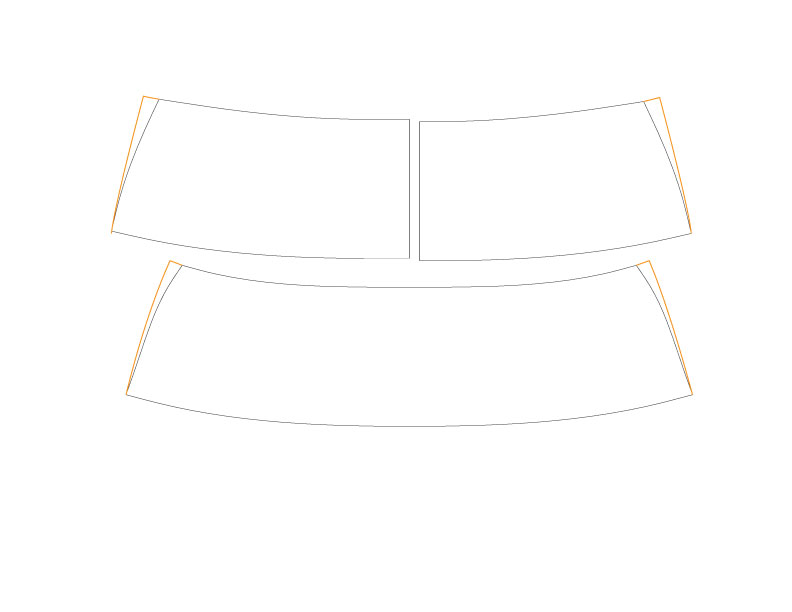
You might like to change the style of the waistband to better suit your figure. I would recommend reducing the height of the waistband by at least 1″ or possibly even 2″ so that the pants are mid-rise instead of high rise. If you prefer not to highlight your waist, you will find this rise much more flattering!
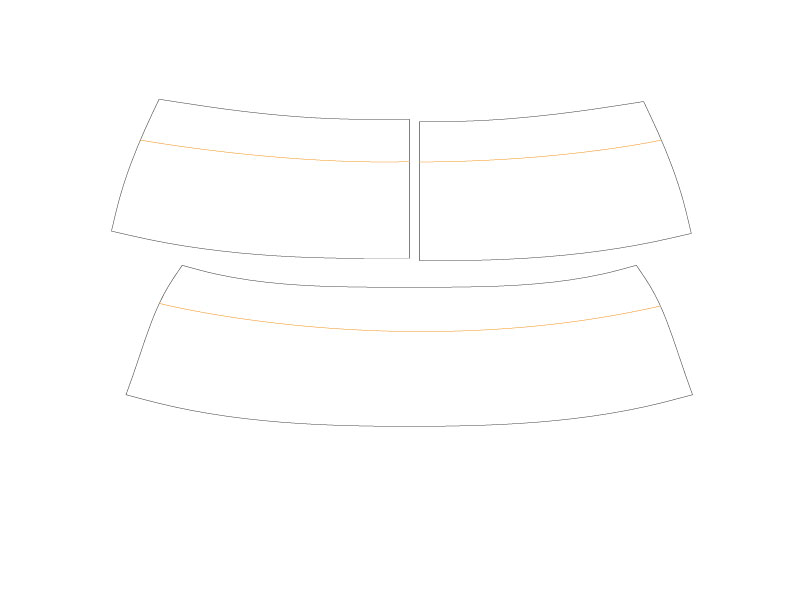
Full Thighs
The Lazo Trousers are drafted to have very roomy thighs (due to the double pleats) so I don’t anticipate you will feel any strain across the thighs when you sew a mock up. There were a few requests for this adjustment though, so here it is in case you need it! If the pant legs are too tight at the thigh you will notice horizontal or diaganol wrinkles across the legs just below the crotch. You will also notice strain at the bottom of the slash pocket. Add more room only on the pants Front pattern piece since a large thigh is caused by a very developed muscle on the front of the leg.

Add the room by extending the crotch at the inseam. If your adjustment is fairly large it might be necessary to lower the center front waist to remove the length that unfortunately has to be added to the crotch while you are adding width. You probably won’t need to do this though – wait until you’ve sewn another mock up to see if the front crotch seam has become pouchy and too long. Here is a PDF from Sew News magazine that includes a very succinct description of this whole adjustment…in case you need a second opinion!
Full Calves
Since the Lazo Trousers feature tapered legs and since the cropped variation includes wide cuffs, you will need to ensure there is enough room for your calves. You can compare the pattern pieces (minus 5/8″ seam allowances) with a comfortable pair of pants that have no stretch and a bit of roominess across the calves. Or you can sew a mock-up of the pattern as is (while working on other fit adjustments) and note if the knees or calves feel restricted when you bend your leg or flex your muscles. To add width, simply redraw the side seams and inseams from just above the knee downwards. Decrease the amount of tapering.
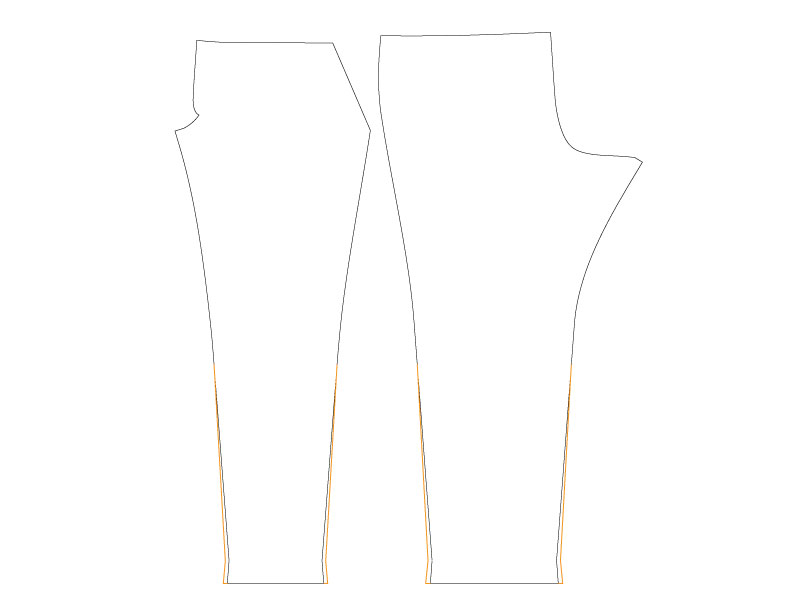
Adjusting the side seams by hand allows you to shape the trousers how you feel they will be most flattering. Make sure to add an even amount of width to the front and back, inseam and side seam so that you don’t end up with wonky twisted legs! You can avoid having to draw new seamlines by hand slashing the pattern and pivoting. This is more complicated but can be a great way to ensure your side seams remain even and straight. You can view an excellent interpretation of this adjustment (along with loads of other useful pants fitting tricks in this post on the Closet Case Files blog).
Oh, and if you are sewing the cropped variation, don’t forget that you will need to add width to the Cuff piece as well!
Whew! Did I miss anything? Keep in mind that these suggestions are simply my preferred approach to fitting and that there are MANY ways of going about fitting! Google your fit problem using this wording: _______ _______ Adjustment (i.e. Full Hip Adjustment, Flat Seat Adjustment). You will find all manner of excellent tutorials!

Let’s close for tonight by drawing the first Lazo Hack contest winner!
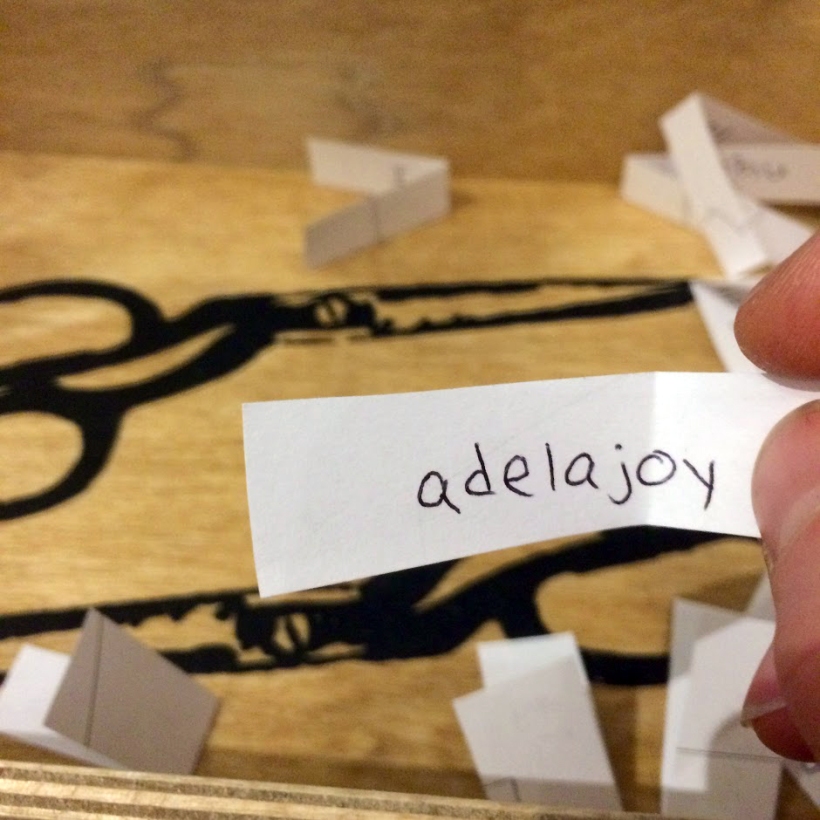
I’m pleased to announce that Robynne (@adelajoy) is the winner of a $50 (US) gift card to Stylemaker Fabrics! Congratulations and thanks for playing along! Here is her lovely sketch of a nautical pair of shorts inspired by the Lazo Trousers pattern.
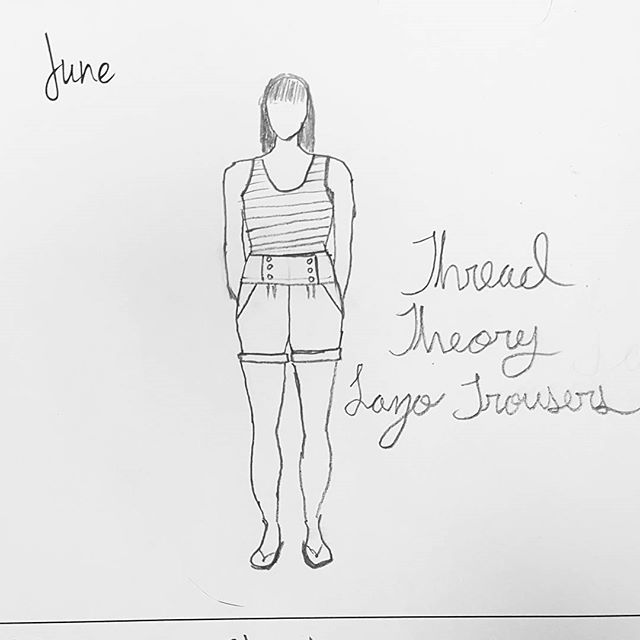
She posted this entry on Instagram using #lazotrousers.
We still have three weeks of prizes to draw. Email me at info@threadtheory.ca, or use #lazotrousers on Instragram or Facebook to enter the contest. Simply share your plans for working on the Lazos or your finished Lazo masterpiece.
The next draw will be on Friday, January 13th. Enter as many times as you want for a chance to win your choice of any 3 Thread Theory PDF patterns. Which patterns are on your wishlist?
Lazo Trouser Hacks: Fabric Choices
It was lots of fun yesterday to receive all of your emails, blog comments and Instagram comments about our Lazo Trousers release! As always, thank you so much for letting me know how excited you are to sew our patterns and also for asking all manner of questions before you delve in. Your questions are helping me to direct my upcoming posts about the Lazos…so keep them coming! Today I’m going to answer what is always the most pressing question when we launch a pattern: What fabric should I use?
The Lazos are a bit of a wild card when it comes to styling. Depending on your fabric choice they can appear dressy, casual, cozy, or even a touch rugged. Over the last few years I’ve sewn airy versions that are best for the hottest days of summer. This is my favourite summery version in tencel (I added a big statement bow to the waist). Of all my versions, I really cant beat these ones for comfort!
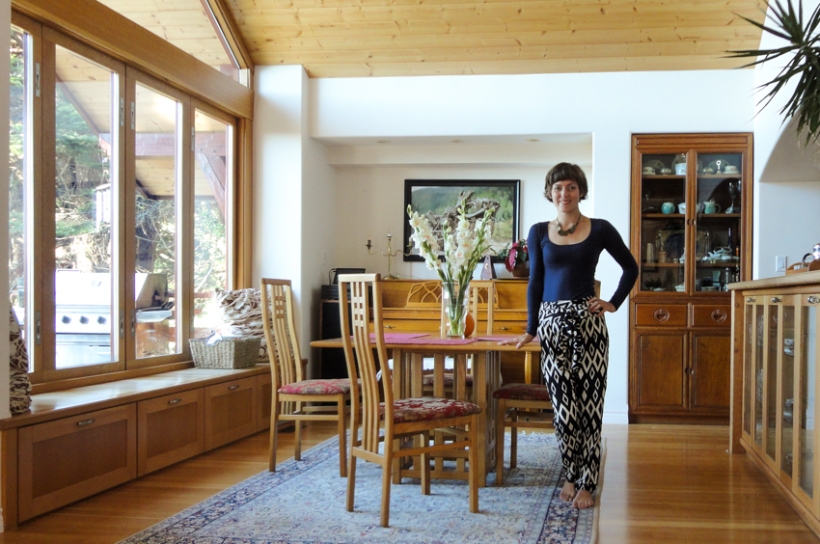
My sweatpant version was a close contender though! I hacked the Lazos while I was in school to create heather grey sweatpants with a satin ribbon draw string (that’s the only pair I’ve actually worn out…I guess that says something about my dressing habits!). A sweatpant hack will be on the blog in January as part of our Lazo Hack contest!
I’ve also created some active wear cropped Lazos that were intended for summer hiking using a poly twill. Photos of these will be on the blog soon (once Matt has had a chance to photograph me).
Lastly, of course, you can’t beat the classic ‘work’ trousers in a wool blend suiting:

Can you see what I mean about the pattern being a wild card?
So, when you ask what sort of fabric you should use…the answer is not a quick one! Let’s dig in:
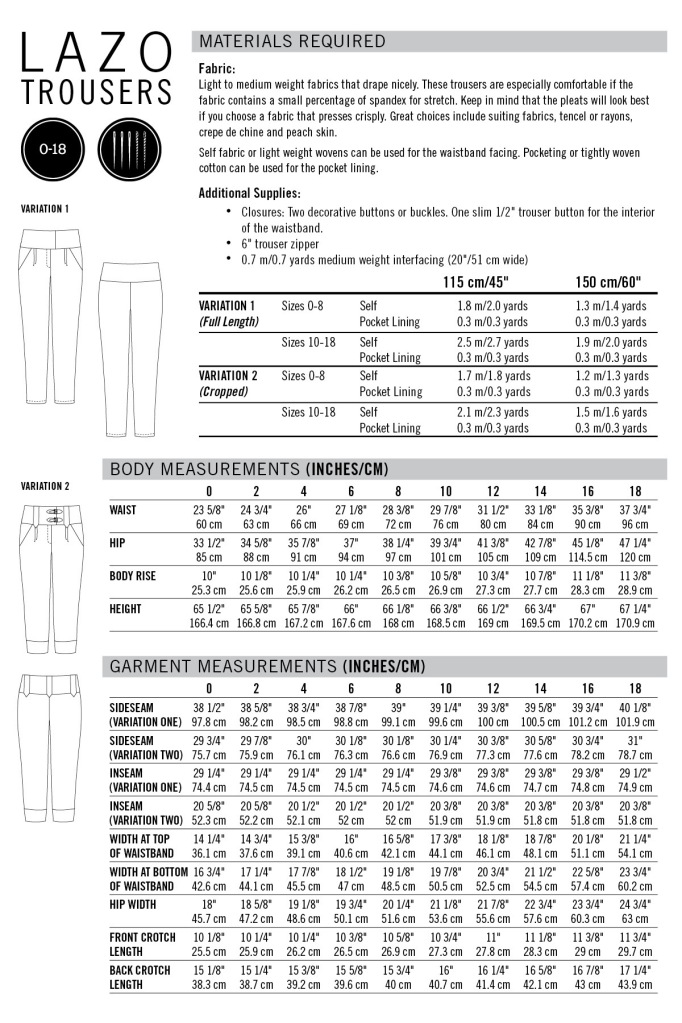
Within the instruction booklet I recommend the following:
Light to medium weight fabrics that drape nicely. These trousers are especially comfortable if the fabric contains a small percentage of spandex for stretch. Keep in mind that the pleats will look best if you choose a fabric that presses crisply. Great choices include suiting fabrics, tencel or rayons, crepe de chine and peach skin. Self fabric or light weight wovens can be used for the waistband facing. Pocketing or tightly woven cotton can be used for the pocket lining.
The main information to take from this paragraph is the recommended weight, drape, stretch, and pressing ease of the fabric. I’ll elaborate on these criteria without actually naming any types of fabric. That way you can get a deeper understanding of what properties you are looking for. If you’re excited to get shopping and just want some actual fabric options, scroll down to find them near the end of this post!
Weight
Most trouser patterns call for mid to heavy weight fabrics but the Lazo Trousers do not. If anything, I recommend choosing something on the lighter side! The reason I recommend light to medium weight fabrics is because there is a considerable amount of fabric situated across the belly and thighs – there are pockets, pleats, and an overlapping wide waistband all in one small area! Using a lighter weight fabric, regardless of its ability to press or drape, will help to ensure that the Lazos do not look bulky across the lower tummy and upper thighs. A light to medium weight fabric is more likely to sit close to the skin softly rather than fold and buckle rigidly. Lastly, a light weight fabric matches the look and feel of a super comfortable full gathered maxi skirt that was my inspiration for this design.
If you want to experiment and choose a heavier weight fabric, make sure that it drapes very nicely – it will work best if it is loosely woven and soft. This raw silk version of the Lazos is the thickest fabric I have used but it is very light and soft because it is loosely woven. The waistband is fairly bulky and, I think, looks best with an un-tucked shirt as a result.

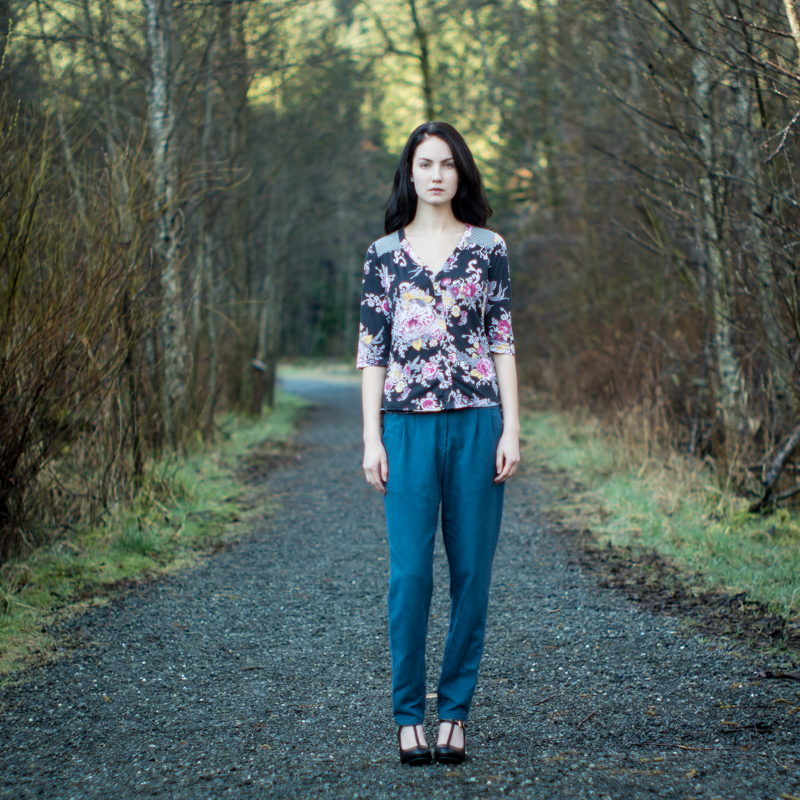
Drape
In my opinion, soft drape (sometimes called ‘good drape’) is the most important criteria for the Lazo Trousers. As my instructor always said in design school, drape is a deceivingly tricky thing to quantify and understand. Essentially, drape is the way a fabric hangs on the body. There is a very informative blog post about drape on the blog “Cucicucicoo”. Lisa has included an excellent selection of pictures showing ‘good’ drape fabrics vs. “low” drape fabrics. Here is an example from her post:
I think the Lazos look consistently best, regardless of fabric type, when the fabric wants to form itself to the body’s shape and fall fluidly towards the ground. Choosing a fabric with soft drape will encourage the pleats to sit closely against the legs, ensure the waistband looks smooth and perfectly formed to the curve of the waist, and allow the legs to remain smooth and crease-free.
If you are feeling like experimenting, I would love for you to prove me wrong about drape! The only Lazos I have sewn with a stiff, rigid fabric are the cotton muslin samples that I sewed while developing the pattern! I imagined the design to be soft and fluid so I was never inclined to sew structured trousers. If you end up sewing with a stiffer fabric, be prepared to accept some wrinkles after sitting and a bit of volume from the pleats (this isn’t necessarily a bad thing depending on the look you are going for! Maybe your going for the chic 1920’s look featuring voluminous jodhpurs?).
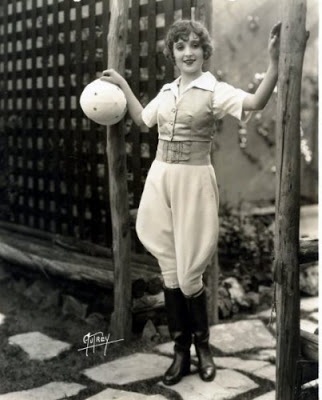
(Source: The Maryland Historical Society)
Stretch
The Lazo Trousers are designed for fabrics with no stretch but that doesn’t mean you need to avoid stretchy fabrics! Sew them in a fabric with a little bit or spandex or even in a very stable knit! Many suiting fabrics and bottom weight fabrics contain about 6% spandex these days – these would result in a very comfortable pair of Lazos! The waistband is very closely fitted so you will not need to size down to accommodate for stretch.
With some modifications to the pattern, a stable ponte de roma or sweatshirt fleece make for creat Lazos (the sweatpant hack I was mentioning). Don’t try to sew the waistband as drafted (without my upcoming mods) in a knit fabric though – there wouldn’t be enough structure for the centre front overlap to look nice and crisp. You could try sewing a woven waistband and cotton legs though! Oooh, that would be comfortable!
Press Crisply
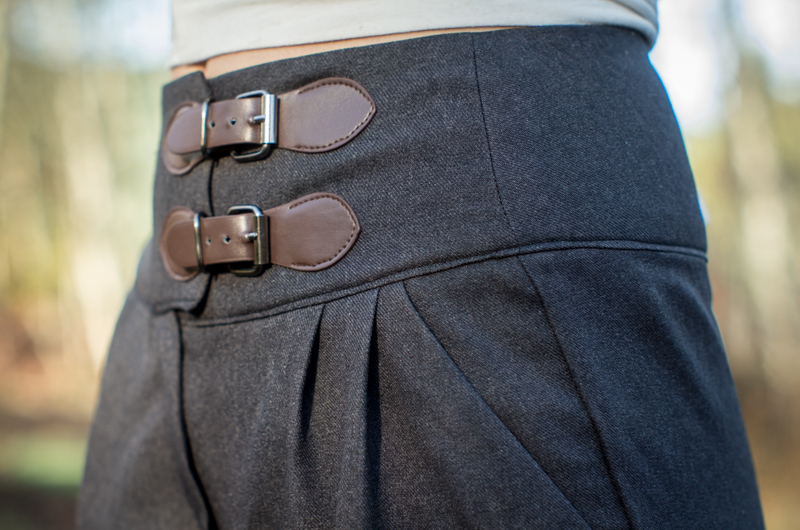
I encourage you to choose a fabric that presses nicely so that your pleats look crisp and professional. At the same time, you will probably want to avoid fabrics that wrinkle exceptionally quickly since the loose legs may become creased when you sit down. Some gentle creasing (just as you will notice on most wide leg trousers) is just fine…but you don’t want to choose fabrics that crease at the slightest provocation. Test a fabric by bunching it up in your fist and letting it warm in your closed hand. Release the bunch and examine it to see if it falls flat or if it remains a crumpled ball. If the fabric does not remain entirely smooth but only has light creasing, it will still work for the Lazos!
Now that you’ve read my reasoning, here are my top fabric picks for the Lazos.
Tencel
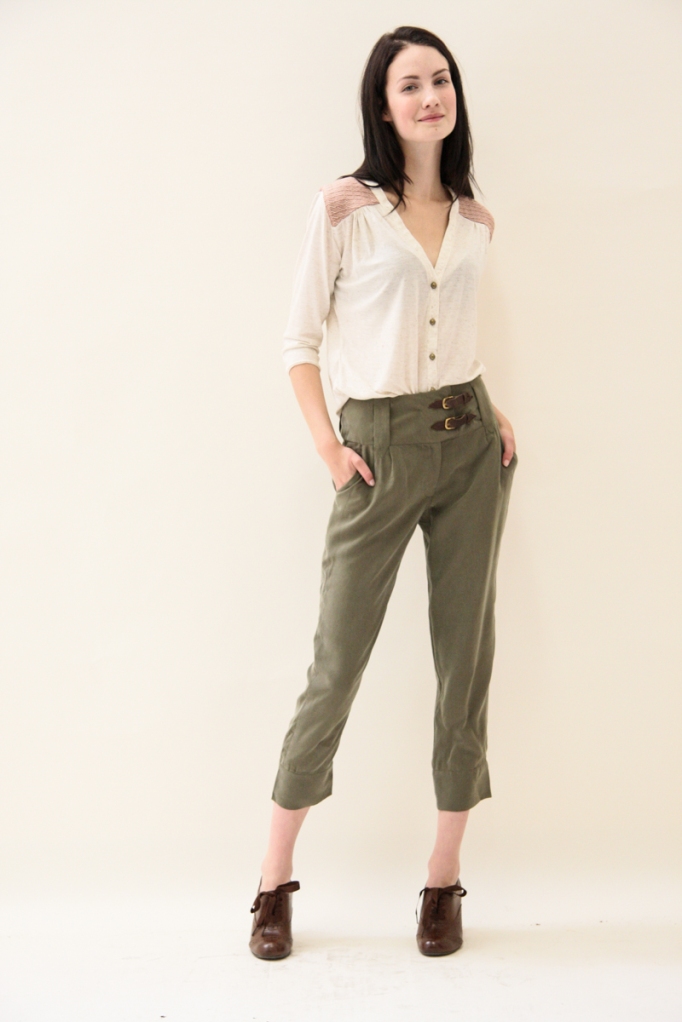
I cannot recommend Tencel enough for the Lazos. Indeed, I designed the Lazos with this specific moss green fabric already purchased and sitting happily in my fabric stash (it was fueling my imagination!). My favourite source for Tencel is Blackbird Fabrics, an online fabric shop based out of Vancouver. Caroline currently has two weights stocked in her shop – both would be excellent choices for the Lazo. The above green version is similar to her lighter weight option (though I purchased the green fabric from a shop near my school years ago).
Here is a navy blue Tencel that she currently has in stock:

She describes this as a twill with a unique brushed surface and suede like texture. It has very good drape and just enough body to hide bumps that you don’t want to show.

I have just finished sewing myself a pair of Christmas Lazos in Blackbird Fabric’s slightly heavier tencel twill. They are dreamy! The twill weave is a bit more pronounced with this fabric. I look forward to showing my Christmas outfit to you in a future post!
There are quite a few beautiful colors (in both weights) within the Blackbird Fabrics online shop. I am tempted by the camel color for my next pair!
Suiting
If you plan to sew the Lazos in a suiting material, be aware that there are MANY suiting fabric styles with all manner of properties. Not all of them will work well! Make sure to choose a light weight suiting that drapes well. To give you an idea of what I mean: It should be thin enough and soft enough that you would need to add a LOT of interfacing and structure if you were to use it for a blazer. Stylemaker Fabrics (an online shop based in the US) is an excellent online source for beautiful yet affordable suitings. Here are my top 3 picks!
Pick one is a solid brown stretch suiting featuring polyester, rayon and lycra. The polyester would make this fabric hard wearing, the rayon would allow the fabric to drape softly, and the lycra would make for a super comfortable waistband! The brown is a nice versatile colour. The other solid is a rayon and lycra stretch twill in wine. The rich colour paired with the beautiful drape of rayon would make for a very dressy pair of trousers. My third pick is this statement Shepherd’s Check! It features polyester and rayon (so there is no stretch).
I had actually purchased this fabric to make a pair of Lazos inspired by English riding attire but it got swallowed in my fabric stash and I just recently unearthed it to create a vest for Matt (the first sample of a future menswear pattern!)! If I wasn’t told that it has no wool in it, I would never believe it! It feels luxurious and high quality.

I have a bit of (likely) unwanted advice for you…You may have noticed that I have not featured any wool suitings. I am a huge wool enthusiast so, if you are too and can source lovely light weight wools, please go ahead and cut into your bounty to create some Lazos! Before you go crazy trying to find the right wool (I have a hard time sourcing nice light wools), consider this: If you like your clothes to wear well without much special treatment, choose a polyester blend suiting. I know many sewists steer clear of poly blends in favour of pure wool, but this is a situation where a bit of polyester will be very beneficial! A wool or rayon and poly blend is a good choice for trousers because it withstands abrasion and remains looking new (without special care) for longer than pure wool. Even more important for the Lazos: Wool/poly blends generally drape better than pure wool suiting materials. An added bonus is that blended suitings are generally very easy to source and are quite affordable!
Bottom Weight Fabrics with Texture
My last fabric category to discuss today is a grab bag…really this category is just a mish mash of all my crazy ideas to help you ignite ideas of your own. I have found that the Lazo Trousers are a great canvas for light weight fabrics with unusual textures! As long as you can ensure the fabric has the weight and drape we have discussed, why not try rich velvet, adventurous faux suede, airy rayon crepe or matte peachskin?
All fabrics from Stylemaker. Top to Bottom, Left to Right: Faux Suede, Jacquard, Peachskin, Metallic Rayon Crepe, Chevron Rayon Crepe, Bold Rayon Crepe, Cranberry Stretch Velvet
These options are untested by me but I think, based on my experimenting over the last few years, they could be stunners! The rayon crepes would create summery Lazos similar to my Tencel versions. The Faux Suede would definitely create that safari look that I mentioned! I purchased the black Jacquard to make myself a pair of Lazos…it remains languishing in my stash but it will emerge one day! It has the lowest drape of all these choices and would definitely create voluminous pleats. I think this would result in a great silhouette for New Year’s parties! Last, but certainly not least, the stretch velvet is beckoning to me…how about you? Of course, the pleats would not press well and working with velvet would require some careful forethought…I think I would convert the double pleats to one large pleat on each side of the fly and leave the folds unpressed so as not to crush the velvet. I would also add a lot of interfacing to the waistband and cut the waistband facing from a thin cotton to add structure.
I hope I have your creative juices flowing! Send me a link or a photo of the fabric you are considering and I will give you my opinion :).
Next week I will be sharing my inspiration and styling photos on the blog. That should be a fun post!
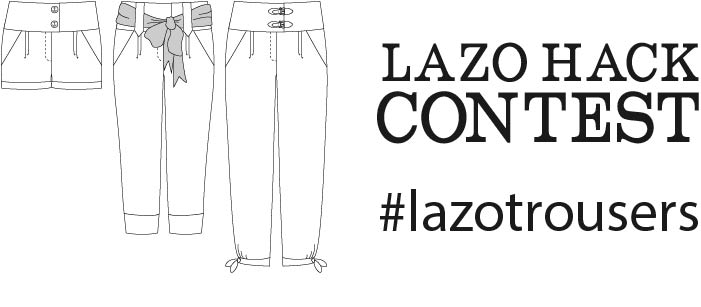
To close for tonight, I want to remind you of the Lazo Hack contest! It will run the rest of December and all of January. I had intended to explain it further in this blog post but this has become rather long…stay tuned for a small post of it’s own next week.
Lazo Trouser Hacks: Style Inspiration

Christmas is quickly approaching so this will be my 2nd to last post about the Lazos before a short holiday. I will be posting about some Christmassy Lazo outfits on Friday and then will be taking a break from blogging until January 2nd. We will be kicking off the New Year with all the fitting posts, tutorials and Lazo Hacks that I have been promising to you! Today’s post is meant to get your creative juices flowing before you have a chance to cut into your Lazo Trousers fabric. I imagine many of us will be too busy spending time with family until the end of the month to actually delve in to sewing something for ourselves – that’s no problem! It just gives you more time to daydream about your creations and post about your pattern hack ideas!
Today’s post is meant to get your creative juices flowing before you have a chance to cut into your Lazo Trousers fabric. I imagine many of us will be too busy spending time with family until the end of the month to actually delve in to sewing something for ourselves – that’s no problem! It just gives you more time to daydream about your creations and post about your pattern hack ideas!
As you are aware, I am hosting a Lazo Hack contest that runs until the end of January. I will be awarding prizes at random until January 31st so the more often and sooner you enter, the higher your chance of winning a prize! Prizes will include digital gift certificates to a great selection of sewing shops and all sorts of goodies that will be mailed to you (worldwide!). Yes…some of our gorgeous Merchant & Mills tools and books will be given away as prizes!
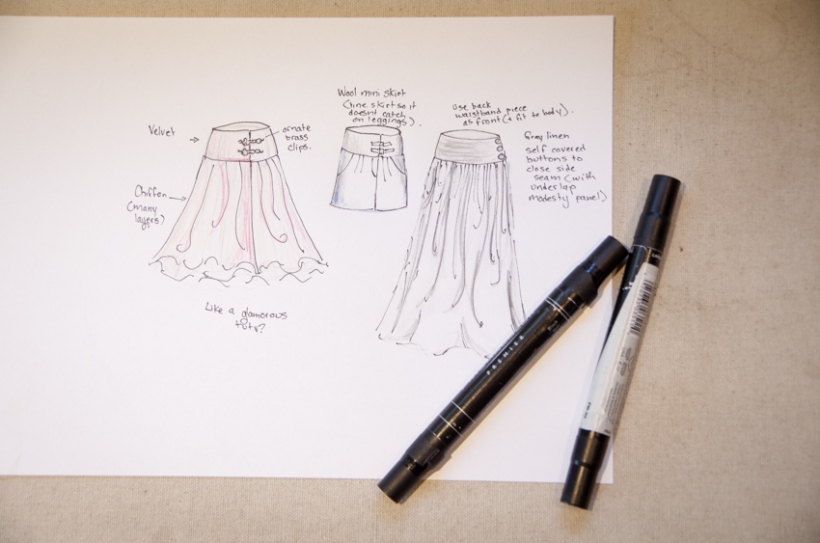
To enter the contest, draw a sketch, share an inspiring photo, take a snap shot of the supplies you’ve gathered, post your WIP, create a tutorial, or share a photo of your finished Lazos! Use #lazotrousers on Instagram or Facebook or email me at info@threadtheory.ca with your images.
The contest is meant to inspire creative interpretations of our Lazo Trousers pattern – meaning you could alter the pattern to suit a figure other than the recommended hourglass shape, you could change the pleats to gathers, you could add width to the legs, or you could even just sew the pattern as is but style it differently than I have done! Anything is fair game!
You don’t need to actually sew your Lazo Hack idea – you could post sketches of a dozen ideas and then pick your favourite to sew. The more entries, the merrier!
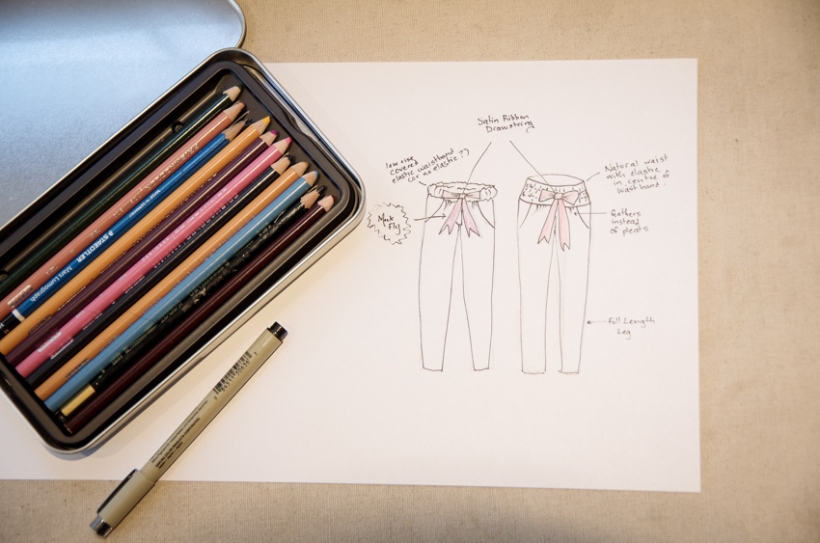
I will be contributing to the Lazo Hack contest by hacking the Lazos into the comfiest and prettiest sweatpants featuring a mock fly, a drawstring waistband, and deliciously cozy terry knit fabric. Stay tuned for a tutorial to create this in January!
Now that you know the details about the Lazo Hack contest, here are some of the inspiration photos that I gathered before drafting the Lazo Trousers in school:
The image on the left is a sketch that I made for my Lazo Trousers design. Sorry for her creepy blank stare – we were told to turn our sketch into a vector (so it could be coloured in digitally on the computer) and I discovered that this is NOT something I excelled at naturally! All of the other images come from a Pinterest Board that I have created for the Lazos. Click on any of the collages in this post to link to the Pinterest board. Unfortunately, I believe you need a Pinterest account (which is free) to view the board but I’ve displayed most of my inspiration in this post for you to view anyways!
As you can see from the five images of modern store bought trousers, I was taken with the idea of a loose, pleated front with stovepipe legs. I noticed, as I was selecting images, that I always preferred the overall silhouette of trousers that sat at the natural waist (instead of the hips). This was a bit of an epiphany for me since, prior to creating an inspiration board, I was sure I preferred very low rise trousers!
Next up, we have these tiny skirt and palazzo trouser images above. They come from Pinterest…which is a great source of inspiration and an exellent way to organize thoughts but it can be hard to find high quality images or original sources! A fitted waistband with a full skirt attached (a dirndl skirt) is my most comfortable silhoutte…but I find I can never wear it because all that fabric is not very practical for dog walking, bike riding, and generally living actively. The free feeling of wearing one of these skirts or palazzo pants paired with the practicality of trousers = my goal for the Lazo Trousers.
The fashion line that I created while in school was called ‘Rationed Fashion’ and it was inspired by British women’s fashion during the second world war. Rationing led to an appreciation of hard wearing fabrics. Women had to select their clothing to suit their new jobs (and often wore uniforms for their work). Design details were subtle and functional so that the garments would remain wearable for many years. I hadn’t watched the show Land Girls yet when I designed the Lazo Trousers but, the Land Girls uniform was exactly what I had in mind (second image from the right, above). As you can see in the photos above, jodhpurs or breeches have often been a working or adventuring woman’s go-to pair of trousers in the last 100 years. They were popular for aviators and equestrian women in the 1910s and 1920s. They were a staple of wartime working women in the 1940s. And there have been periods throughout the 1970s and 80s when trousers with fitted waists, roomy thighs, and fitted calves were in vogue. It is a functional style because it allows full range of movement without excess fabric getting in the way.
The wide Lazo Trouser waistband and slash pockets provide a great blank canvas for small design details. Leather or vinyl buckles are my go to choice but you can also feature self fabric buckles, statement buttons, self fabric covered buttons, or even those beautiful frog closures that are always in fabric stores but rarely get used!
Quite a few of you have shared your ideas for the Lazos with me so far (not as contest entries, but instead as comments…you guys should sketch your ideas and submit them as contest entries!). There are many people planning to make safari style Lazos and there are a couple of you planning to cut in to tartan wool and use kilt buckles. And a number of you want to add width to the legs to create elegant palazzo pants. I’m so excited to see your creations!

